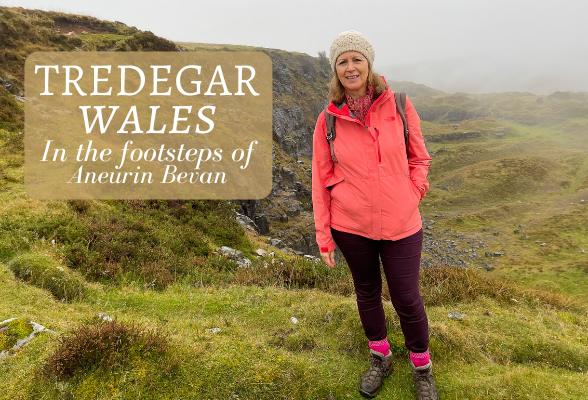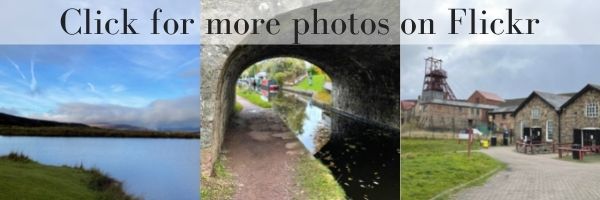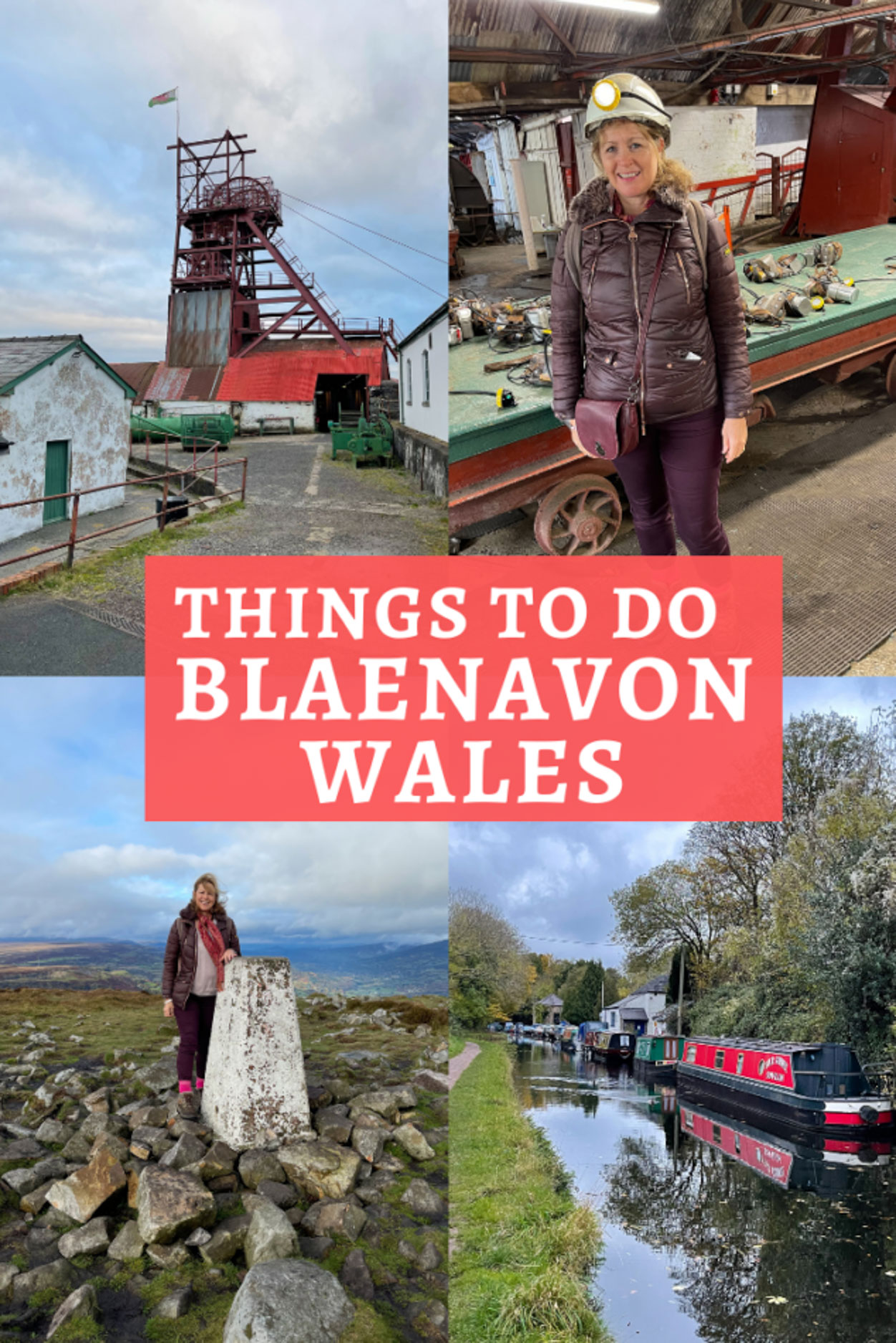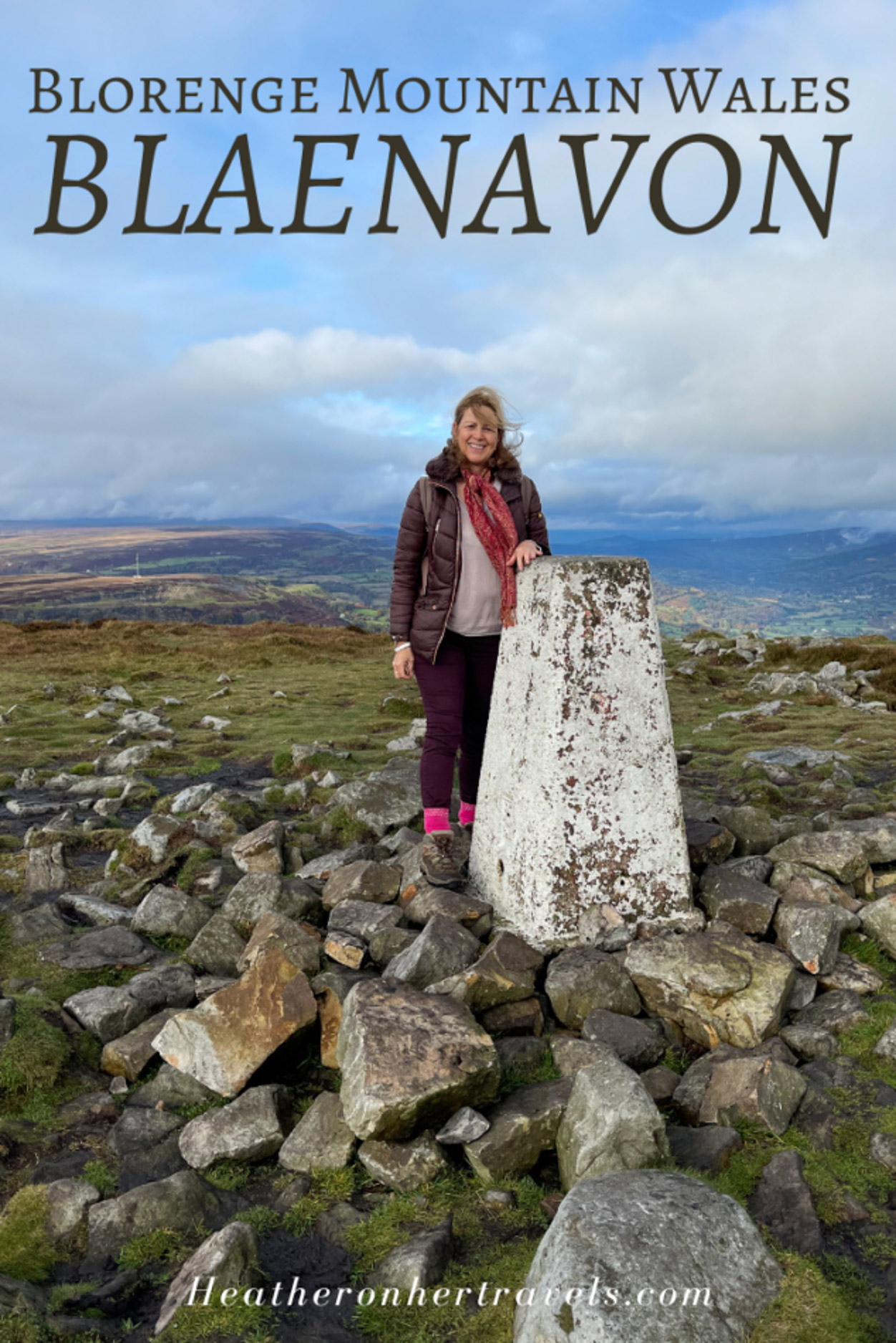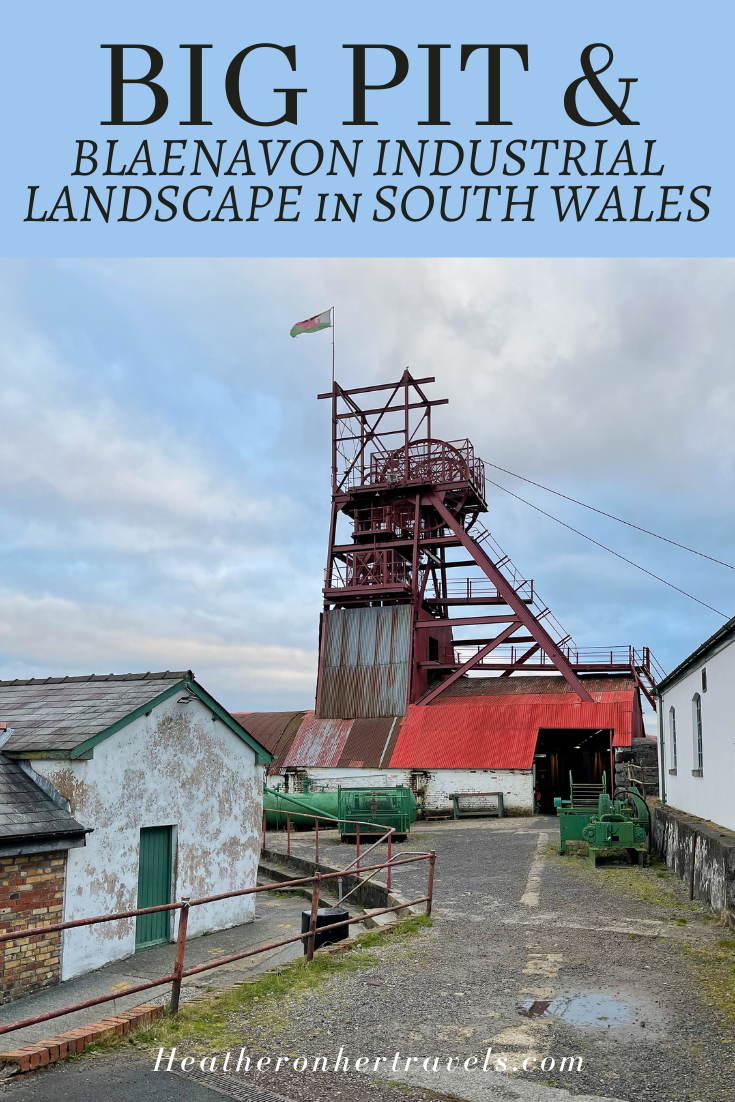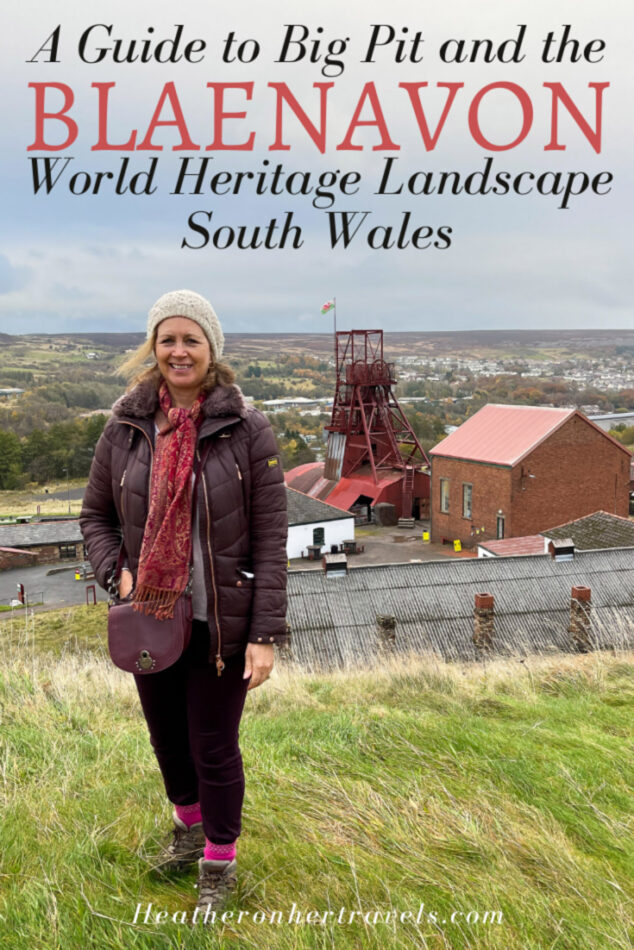Blaenavon and nearby valleys of South Wales were once the powerhouse of the industrial revolution, mining coal and iron ore, that was transported by canal to Newport. The unique heritage of this former mining valley has been preserved in the Blaenavon Industrial Landscape, with fascinating attractions such as Big Pit National Coal Museum, Blaenavon Ironworks, Blaenavon World Heritage Centre and Blaenavon Heritage Railway. Now the hillsides are green again and can be enjoyed in numerous walks, like the one we made on Blorenge mountain within the Brecon Beacon National Park. Read on for our guide to visiting Big Pit and the Blaenavon World Heritage Landscape in South Wales.
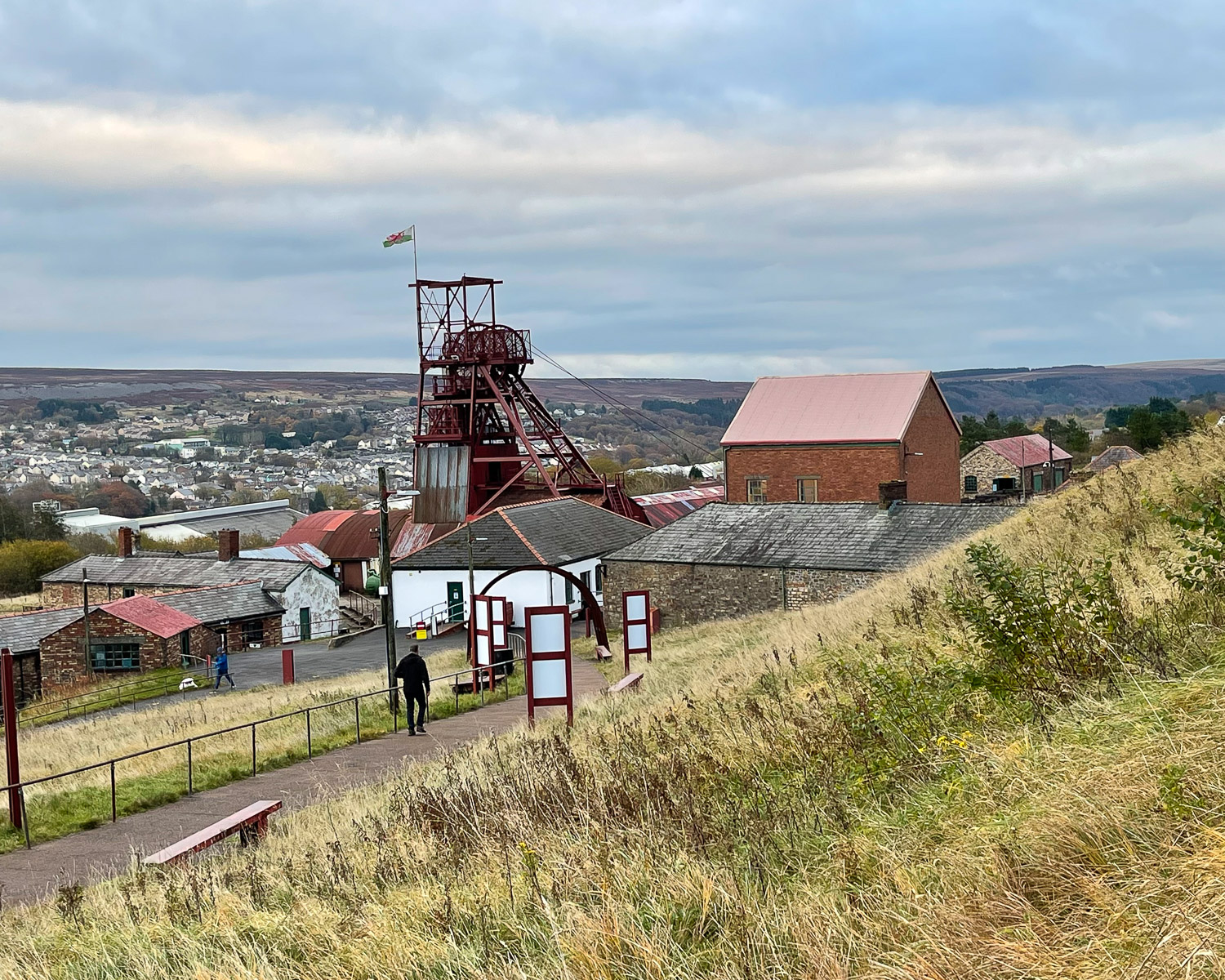
This article may contain affiliate links that provide commission on purchases you make at no extra cost to you. As an Amazon Associate I earn from qualifying purchases.
Big Pit National Coal Museum
The Big Pit National Coal Museum is the best known attraction within the Blaenavon Industrial Landscape, which was designated by UNESCO in 2000. It was a working coal mine for a hundred years from 1880 to 1980, employing up to 1300 miners working underground. The first operation in the area was open cast mining of coal and iron ore, which could simply be dug out of the hillside.
But in the first half of the 19th century the Blaenavon Iron and Coal Company was established and sunk deeper shafts to reach the coal seams further underground. The pit finally closed in 1980 with a loss of 250 jobs, but re-opened as a museum in 1983 to showcase to a new generation the mining history of Wales. Big Pit is free to visit, although there’s a parking charge and you need to pre-book the underground tour.
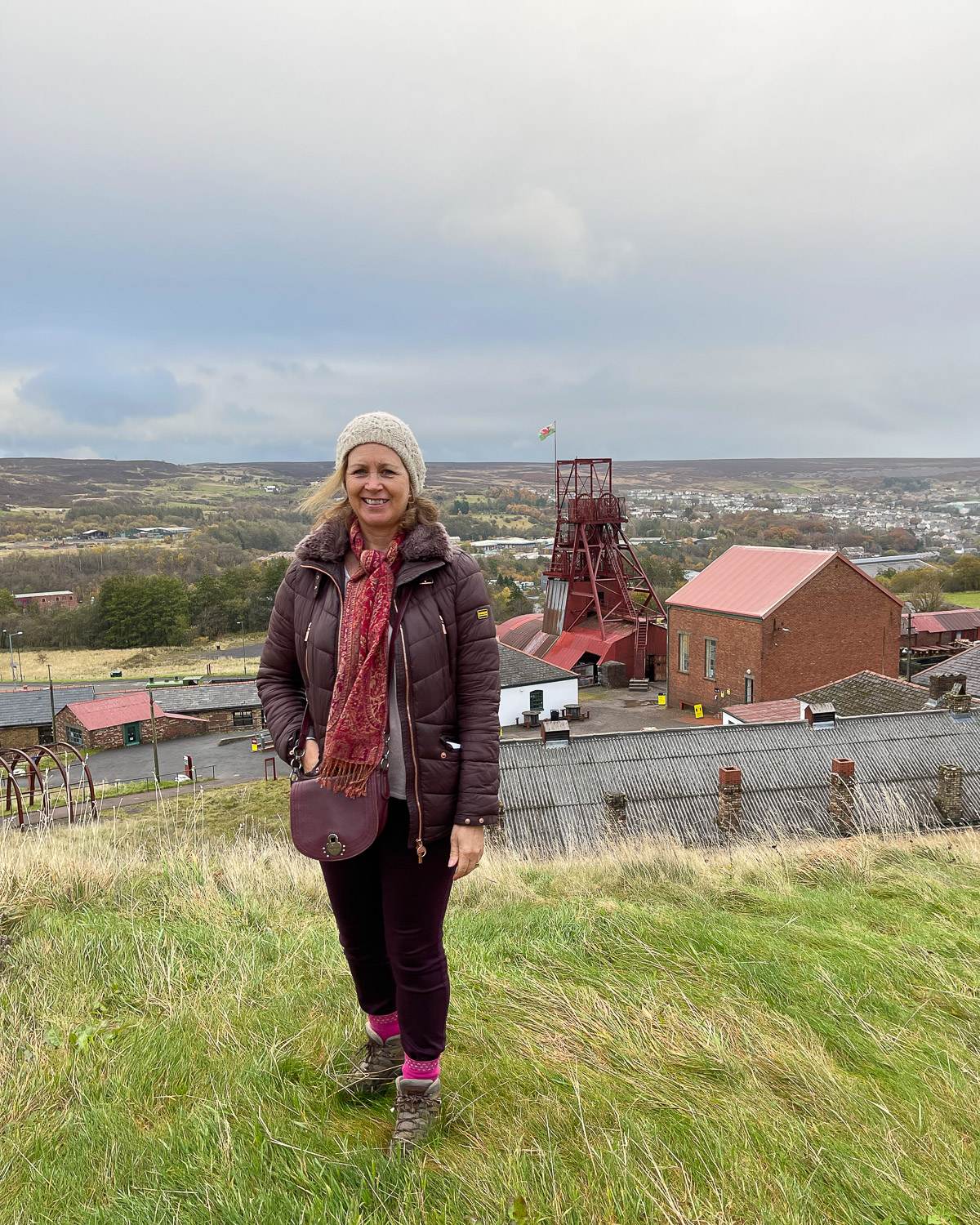
The Underground Tour at Big Pit
The highlight of our visit to Big Pit was the underground tour, which took us 300 ft underground, with guides who were originally miners in the South Wales coal mines. We first donned our helmets with safety lamps and handed in any ‘contraband’ that might cause an explosion. Big Pit is classed as a working mine, so safety is still a top priority. The contraband items included obvious fire risks such as matches or cigarettes but also mobile phones or cameras with a battery – sadly no photos then!
Our pack to sling over the shoulder included a battery for the torch and a breathing mask that would filter foul air in the event of a gas leak, allowing an hour of breathing time to escape from the mine. Our guide Andy described how he once encountered a fire in the mine and used the mask to avoid breathing in the smoke, allowing him to escape unharmed – a quite scary experience which we hoped we wouldn’t encounter!
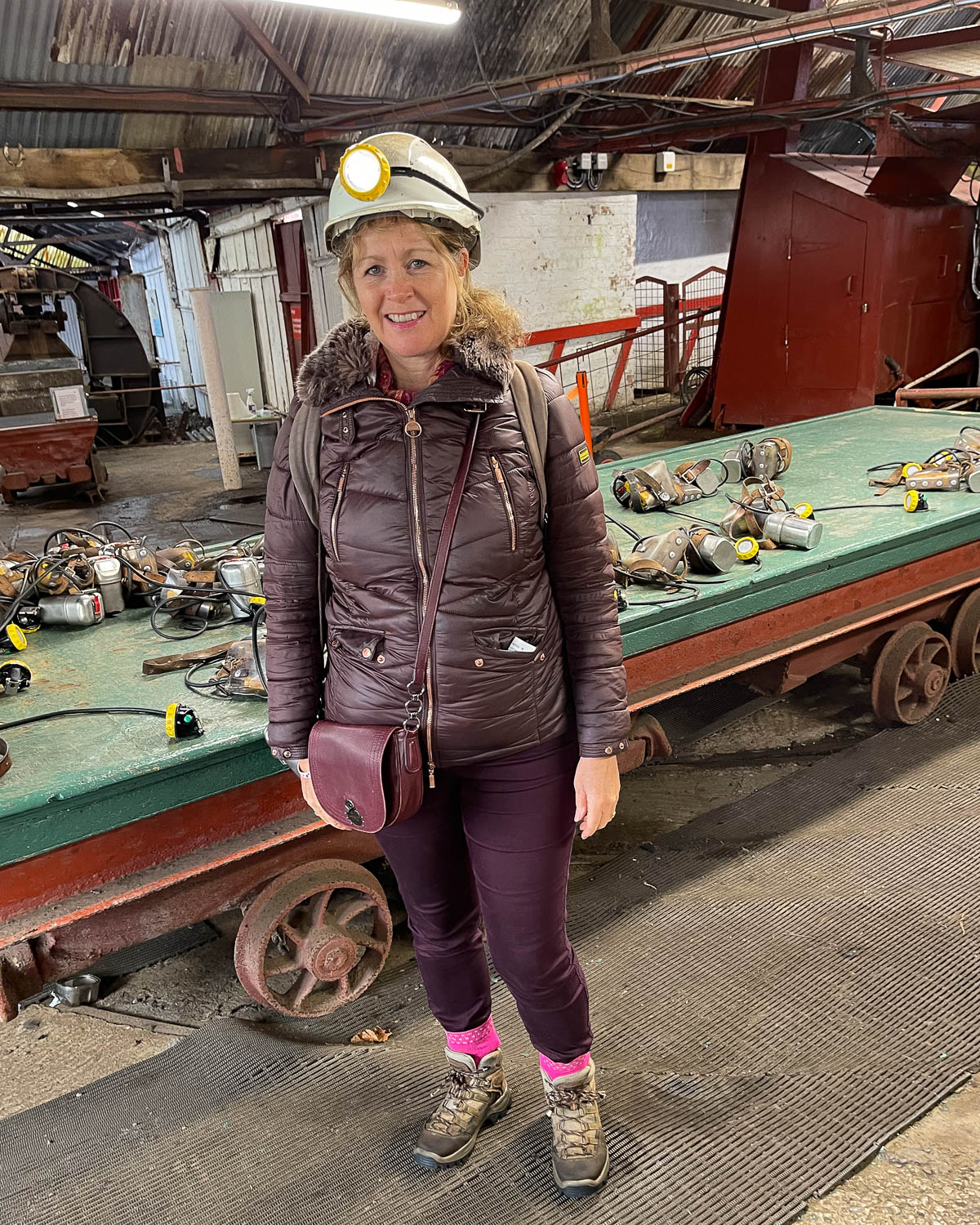
Explore Tredegar Wales – in the footsteps of Aneurin Bevan, father of the NHS
Down the mine in Big Pit
We descended in the cage lift and took the tour through the different passage ways, which were mostly lit only by our own head torches. We listened to accounts of how children were originally used in the mine to open doors and lead the horses, and how men hacked the coal out by hand risking rockfalls, gas leaks and fires. It was obvious how necessary and important the trade union movement had been in improving pay and conditions.
Hundreds of pit ponies also worked underground to pull the carts of coal, only seeing daylight once a year when they had a 2 week holiday in the fields. The tunnels were slippery underfoot and surprisingly low in places causing us to stoop (those helmets got a few knocks!), so I was quite pleased to reach the surface again at the end of the hour.
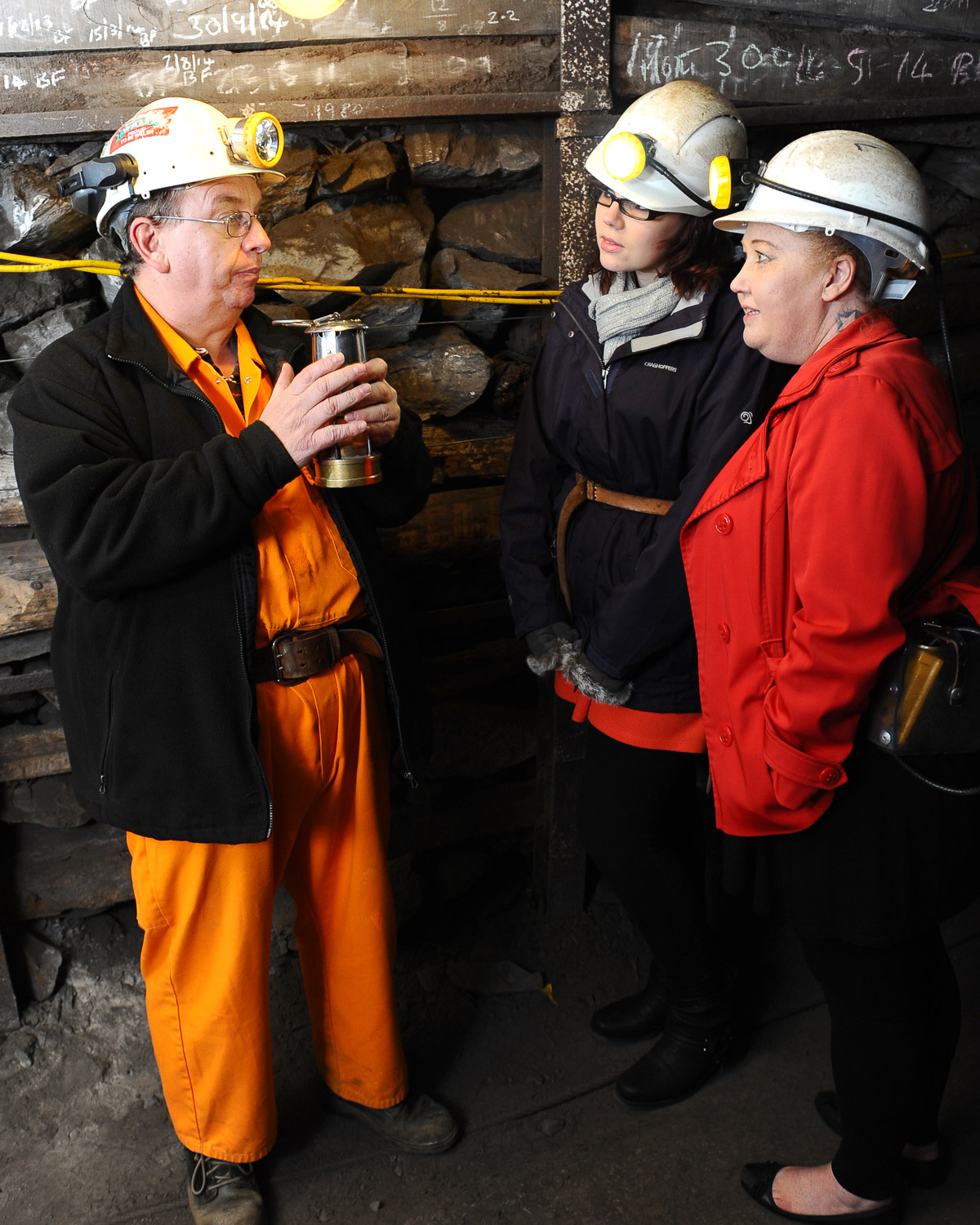
Blaenavon Underground Tours information
- The underground tour takes around 50 minutes
- Only 6 people per tour plus guide
- Children must be over 1 metre tall and accompanied by someone over 16
- Wear warm clothing and sensible footwear. Safety equipment is provided.
- Tours are free but must be pre-booked. You’ll also need to book a free general ticket for Big Pit.
King Coal: The Mining Galleries at Big Pit
If the underground tour isn’t for you or is already booked up, a great alternative is the “King Coal” audiovisual experience. The 20 minute show takes place in mining galleries cut into the hillside, starting with a video explaining how the Welsh Mining industry developed. We walked through three different display areas, with sound and lighting to highlight the underground workings and rock cutting machines.
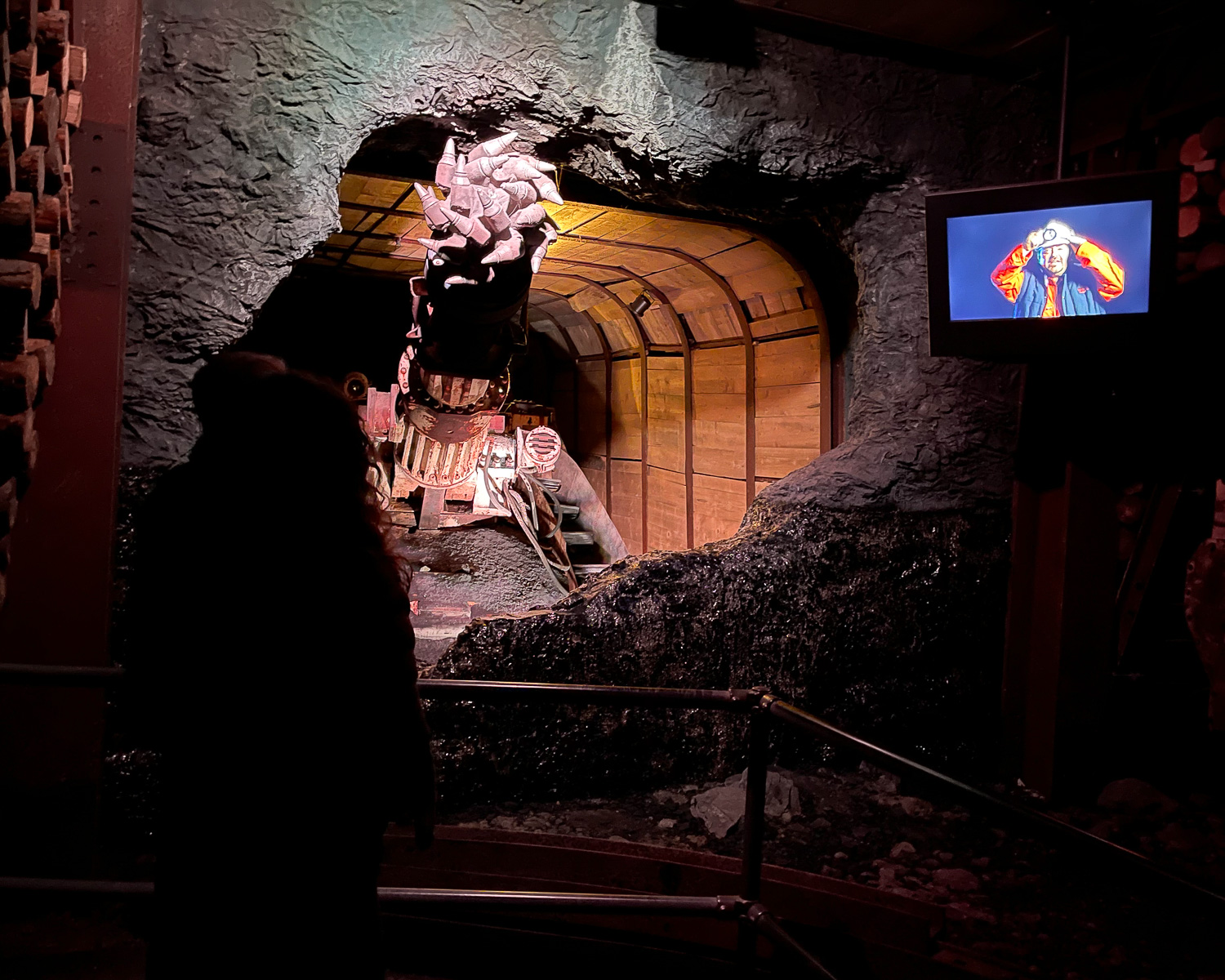
In each place the miner on the video screen explained what happened at different stages of the mining process, accompanied by the sounds of the mine at work. It was a fun presentation and we enjoyed the jokes and humour from the on-screen miner, which seemed to encapsulate the camaraderie that developed in the mines in the face of such dark, dirty and arduous conditions.
Other Historic buildings at Big Pit
After our underground tour, we had a look around the rest of the industrial buildings that supported the coal mine at Big Pit. The Blacksmith’s Yard dates back to the earliest days of the mine in the 1870s, with a forge and welding shop that were used to maintain and repair anything from horseshoes and tools, to parts of the railway.
In the Stockyard we could see stacks of timber that were brought here by train and cut to size in the saw mill. They were used as pit props to support the underground tunnels of the coal mine.
One of the largest features of the site is the Winding House with its wheels and cables to lower the cages into the mine, carrying coal, miners, supplies and now visitors. The engineman operating the Winder has one of the most important jobs in the running of the mine to keep things running safely.
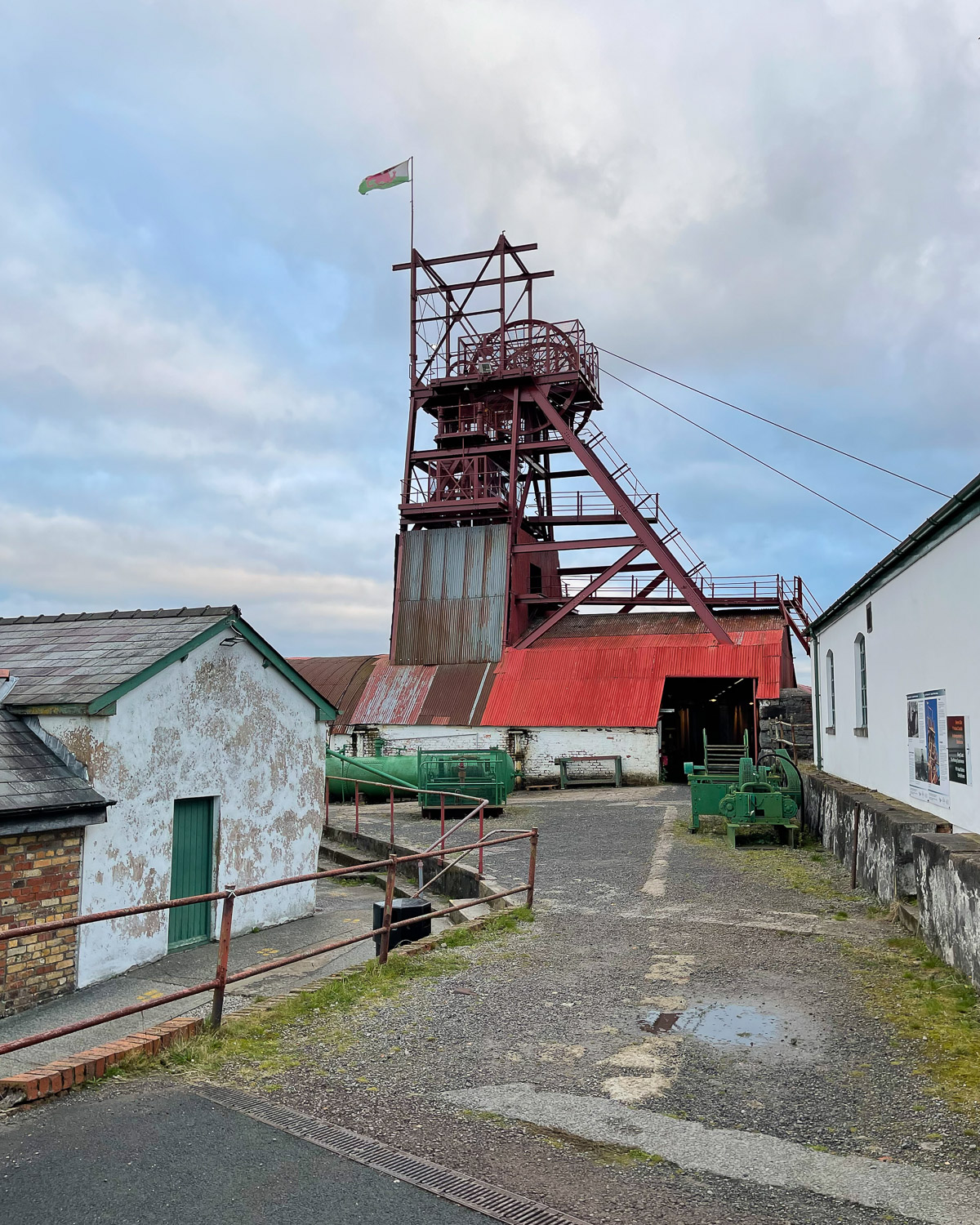
The Pit Head Baths building
For the final part of our visit, we headed up to the top of the hill, where the pit head baths, museum and miner’s cafe were located. The Miner’s baths were introduced in the 1930s, enabling the miners to clean up before going home, so that their wives didn’t have to constantly boil water for them to have a bath in the backyard.
Each miner had a ‘dirty locker’ and a ‘clean locker’ in different parts of the bath, enabling them to change out of their clean home clothes into their dirty working clothes at the start of the shift, and then change back having showered at the end. Although the shower were a communal ‘no frills’ affair, we could imagine what a relief it would be to get clean and warm after a shift, with the camaraderie of miners chatting and relaxing after the dirt and danger of the mine.
The miner’s baths leads into into the Big Pit museum area, with displays of equipment and information about how coal mining developed in the Welsh Valleys and how it declined leading to closures in the 1980s with a devastating effect on the local economy.
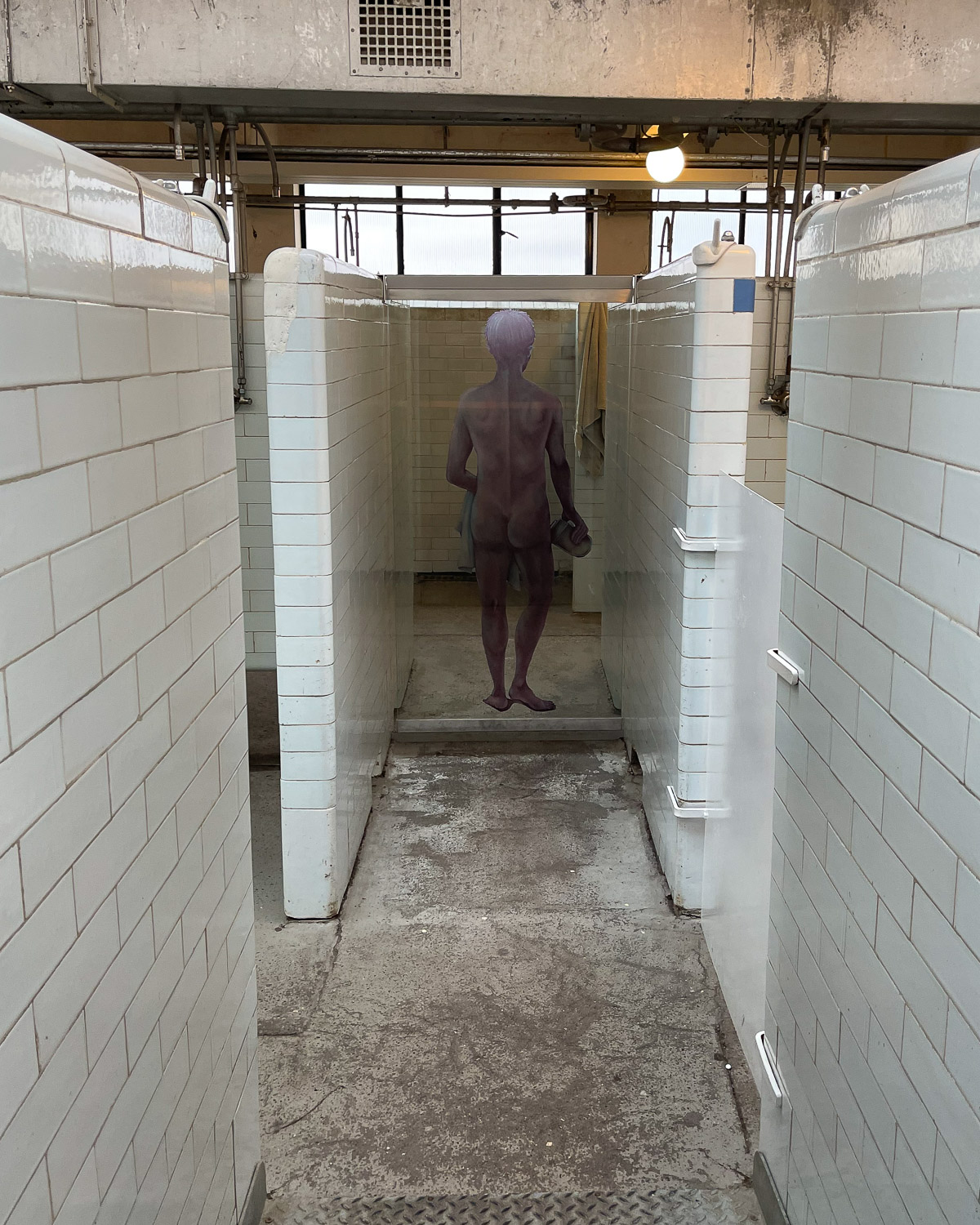
The Miner’s Canteen at Big Pit
After visiting the baths and museum, we ended up with a cuppa and large wedge of cake in the Miner’s Canteen. This is where the miners could relax and chat with their mates at the end of a shift. It now operates as a cafe for visitors where you can buy drinks, cakes and some hot dishes with a Welsh flavour. There are great views from the windows over the Big Pit site and the town of Blaenavon in the valley below.
Discover more in this article about scenic walks in the South Wales Valleys
Plan your visit to Big Pit
The Big Pit National Coal Museum is open daily 10am – 5pm. The Museum is free to visit and underground tours are also free. However to manage visitor numbers, free tickets must be booked in advance. There is a £5 charge for car parking, with machines that take cash or card.
Other coal mines in Wales to visit
Another coal mining museum in Wales that covers the industrial heritage of this area is the Rhondda Heritage Park in the former Lewis Merthyr Colliery. The Black Gold Underground Tour is led by former miners and offers the experience of going underground into the pit, with other on site attractions such as the Caffe Bracchi and an arcade of shops with a heritage theme. I’ve visited the Rhondda Heritage Park on a previous trip – you can read about my experience there in this article – 16 fun things to do in the South Wales Valleys.
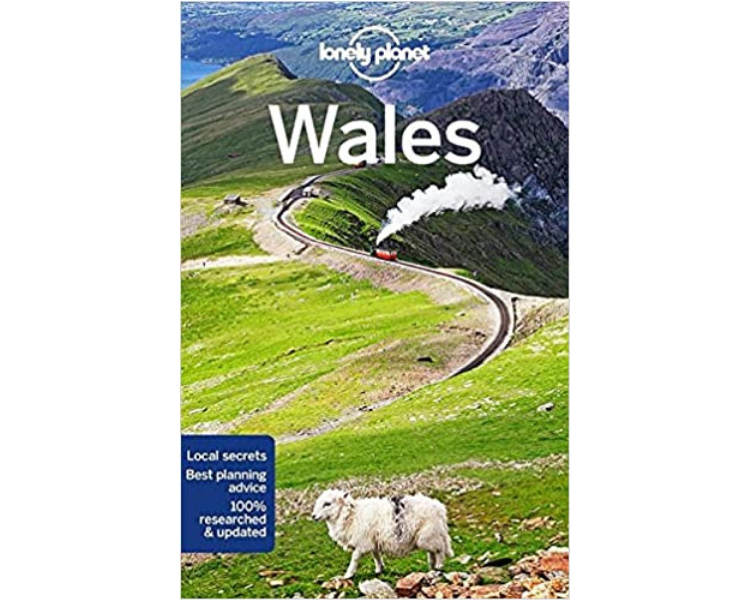
Need a guidebook for Wales? We recommend the Lonely Planet Wales Travel Guide
Blaenavon Heritage Railway
Right by Big Pit, you can catch the Heritage train that runs for 3.5 miles through the Blaenavon World Heritage Landscape. The train wasn’t running on the day we were there, so we had to content ourselves with admiring some of the locomotives that were on display outside Big Pit.
Steam trains mainly run on weekends between April and September as well as some special services for Halloween and Christmas. If you’re a railway enthusiasts, also visit the Railway Shop in Blaenavon Town which stocks model railway equipment, books and toys, with profits going to support the railway.
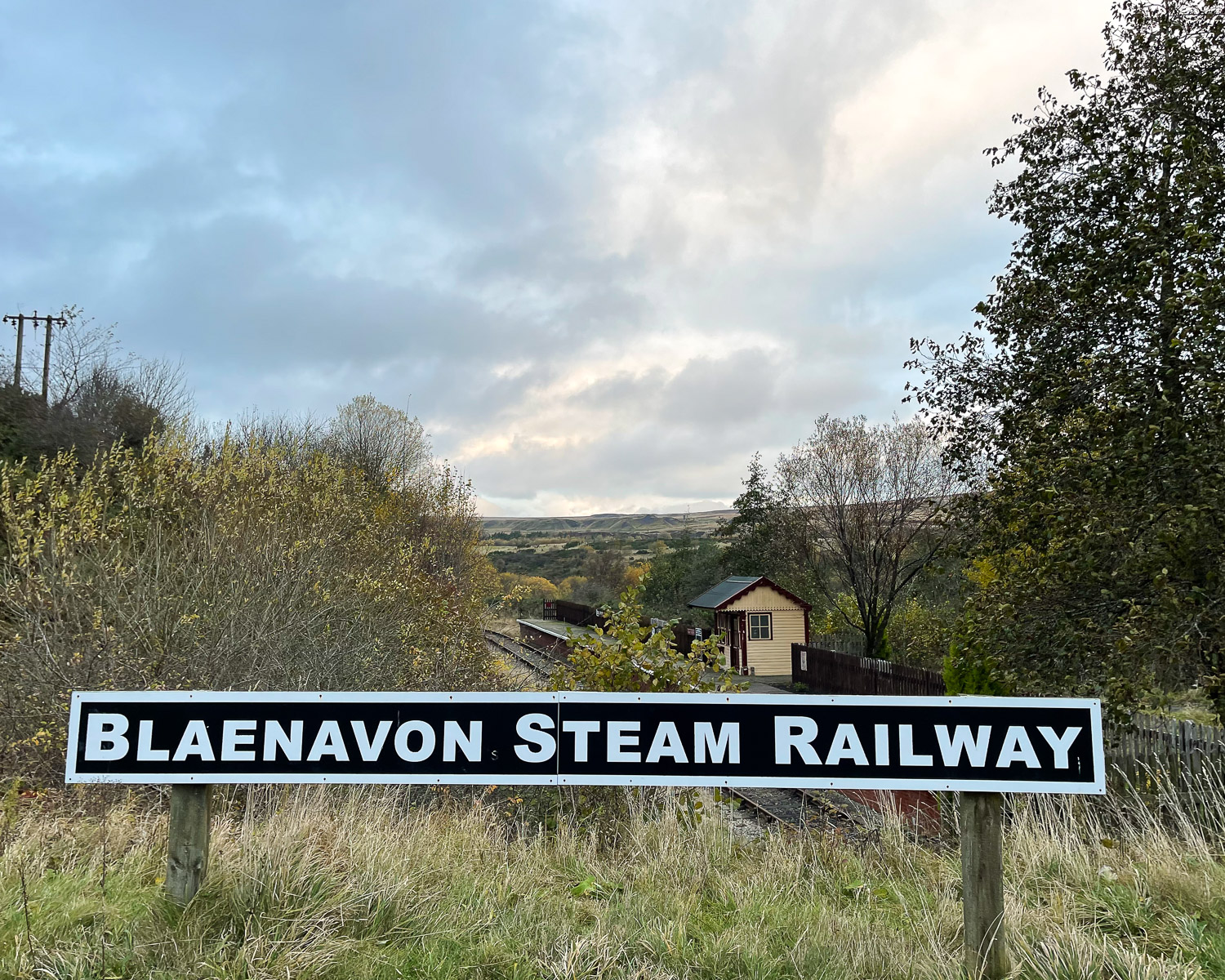
This Heritage Railway is run by volunteers and the round trip lasts around an hour. The route runs between Big Pit, past the main station at Furnace Sidings, to the Whistle Halt Inn and Garn Lakes, then on to the former mainline station of Pontypool. Tickets are valid all day, so you can break your train journey with a walk around Garn Lakes or a visit to Big Pit.
For running times, take a look at the Blaenavon Heritage Railway website
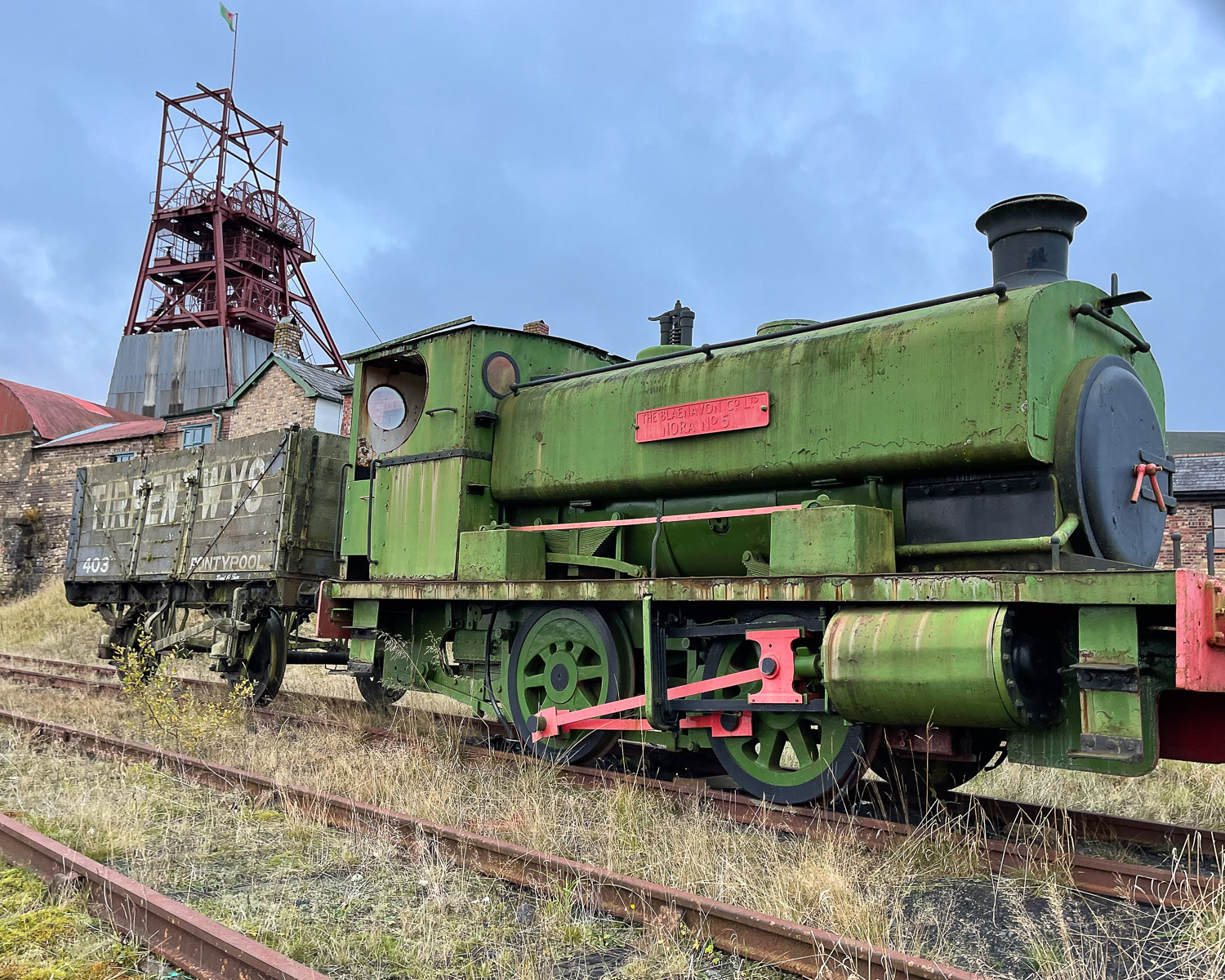
Blaenavon Ironworks
Built in 1789, the Blaenavon Ironworks are another important part of the Blaenavon industrial landscape. They were closed on the day we visited, but we were able to take some photos and look through the railings to see something of the site.
The Ironworks were used to process the rich seams of coals and iron ore that could be mined from the hillside, smelting the ore in the steam powered blast furnaces. The remains of the furnaces built into the hillside can be seen along with the water balance tower that raised wagons 80 feet into the air.
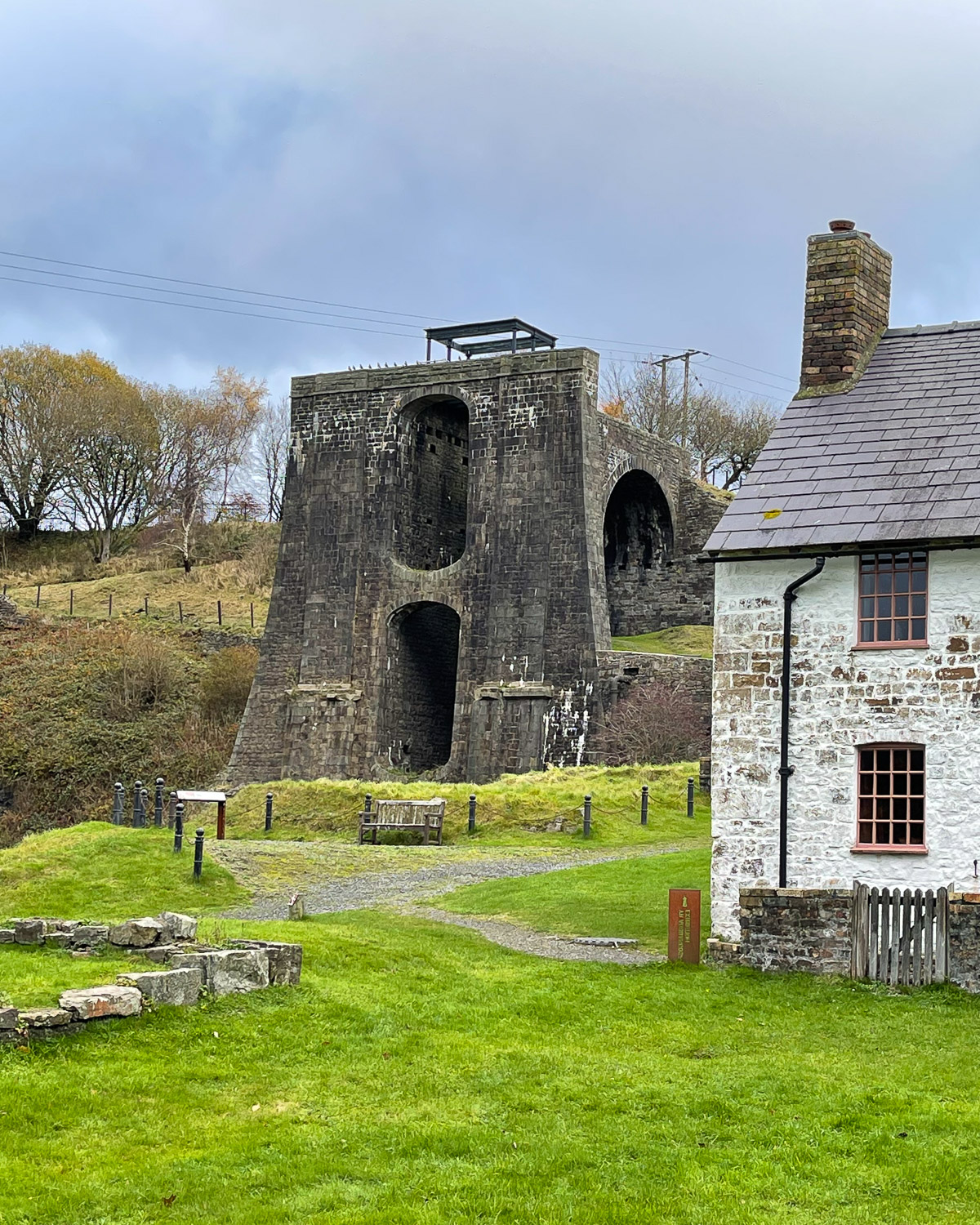
The small stone worker’s cottages on the site have been restored to show what life would have been like for the families of foundry workers. Stack Square, where the cottages are built, also housed the manager’s office and company shop where the workers could spend their wages, with the profits going to the foundry owners. The law changed in 1842, making it illegal for children under 10 to work in the mines. Until then it was common for children as young as 5 to be put to work in the foundry, with girls and boys put to work to break up the iron ore by hand.
The Ironworks are run by CADW and are open Mon-Sun (Apr-Oct) and Fri-Sun (Nov-Mar) – for more details and entry charges visit the Blaenavon Foundry Website.
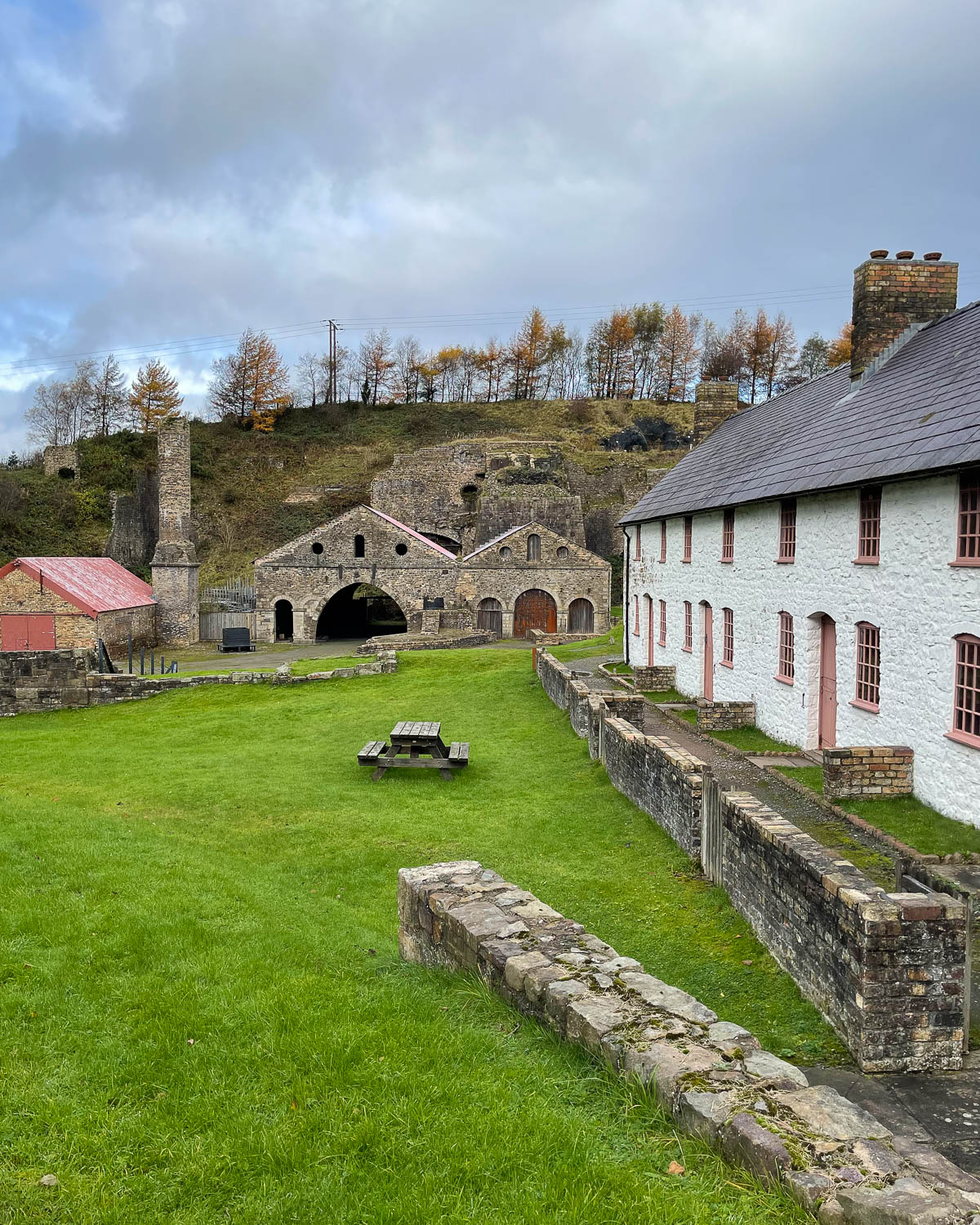
Check out this guide to walking the Monmouthshire and Brecon Canal near Newport, Wales
Blaenavon World Heritage Centre
On the edge of Blaenavon town is the Blaenavon World Heritage Centre, where we stopped for lunch. St Peter’s School was opened in 1816, by Sarah Hopkins, the daughter of one of the founders of the Blaenavon Ironworks. She and her brother Samual, who was an Ironmaster at the foundry, took a keen interest in the welfare of local children. The school was able to educate 120 pupils from local families, at a time when young children were still being put to work in the iron and coal industry.
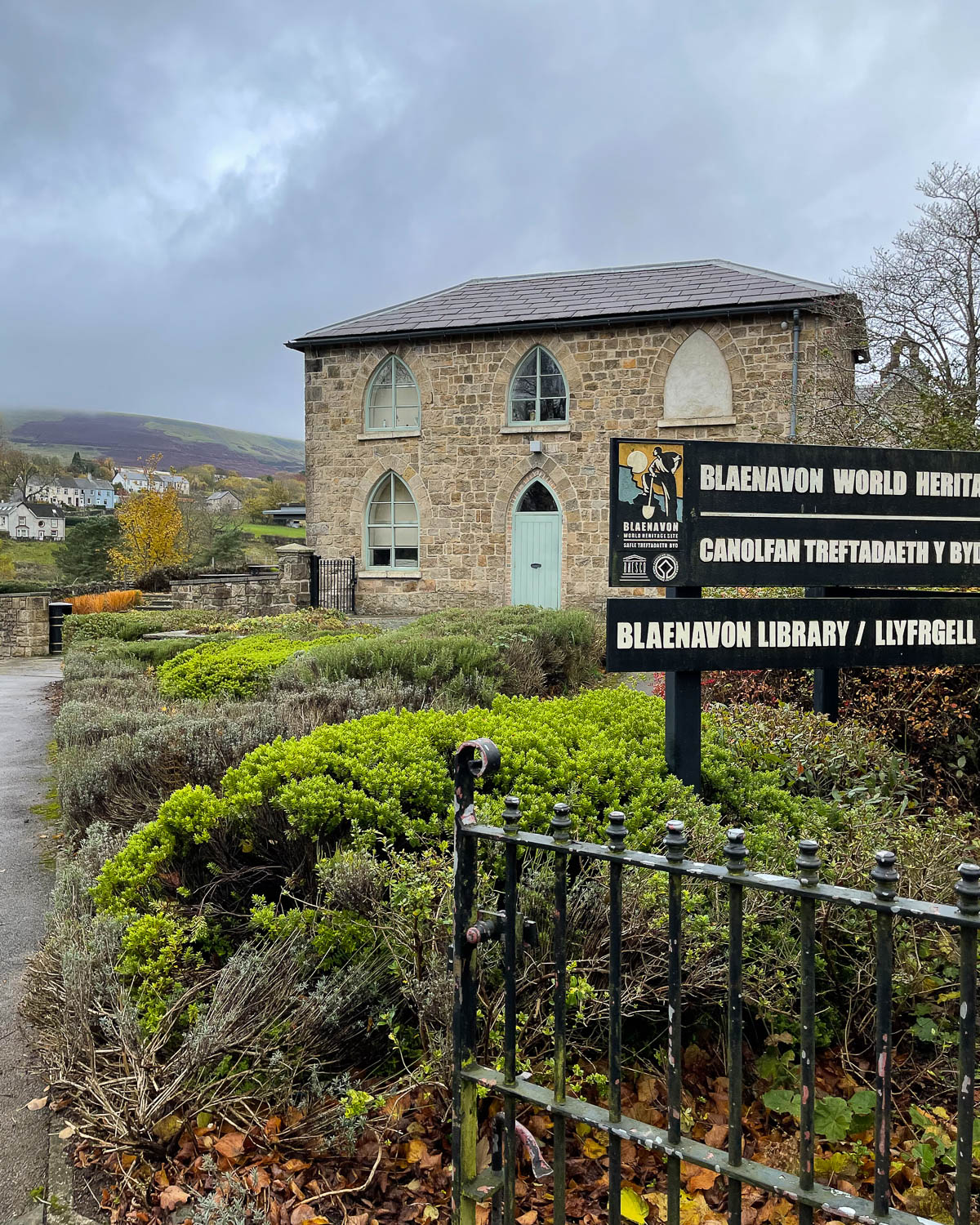
The high ceilinged school house is now an exhibition space, that tells the story of the development of industry within the Blaenavon Industrial landscape. There’s an old school room to imagine the life of a child of the Victorian era being taught here. The centre also doubles as a library and tourist information hub, with plenty of leaflets available on things to do in the area.
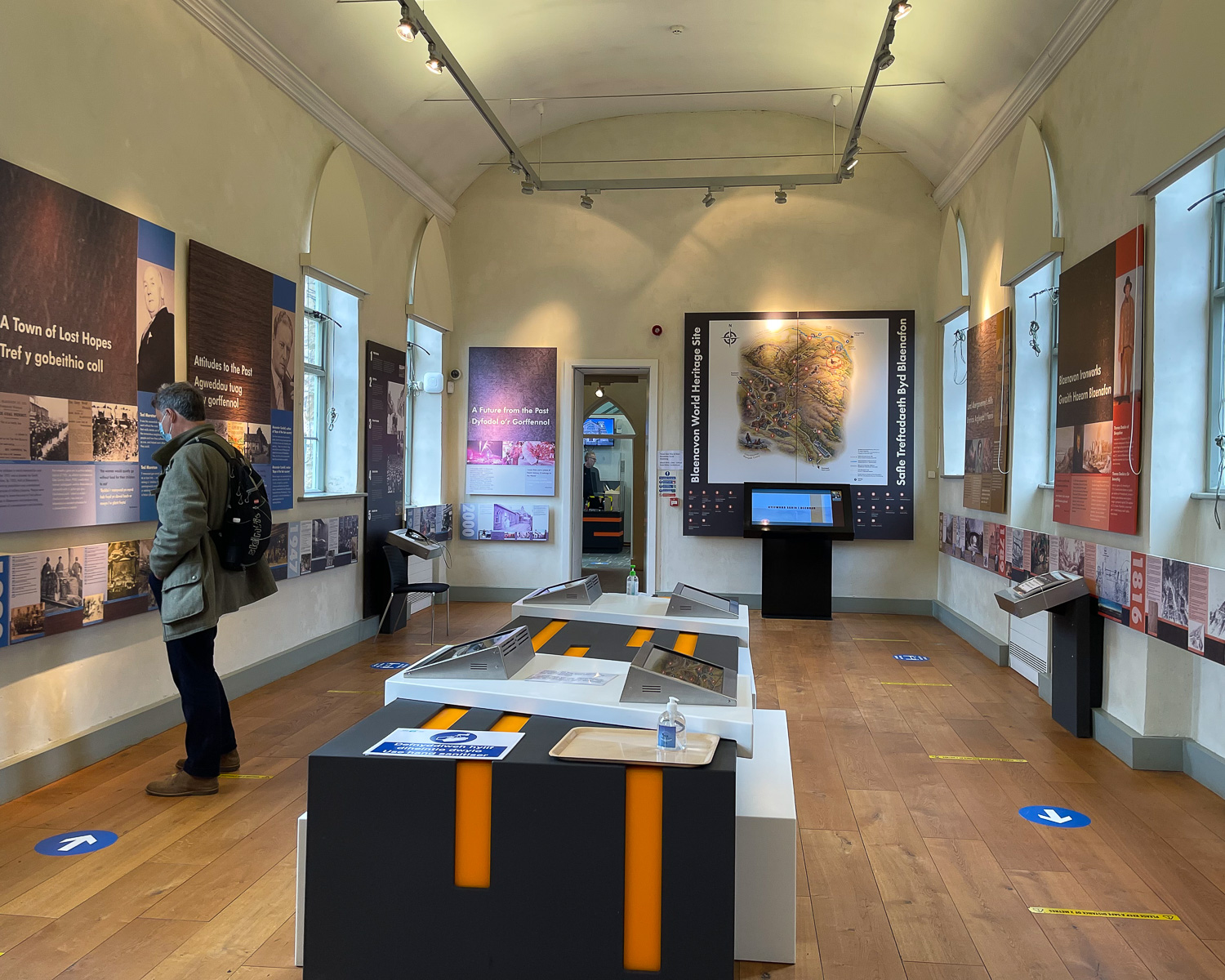
We enjoyed our lunch in the modern cafe at the back of the centre, which has large glass windows and an outside seating area, overlooking the St Peter’s churchyard with views over the green hillside. The cafe serves drinks, cakes, sandwiches and some hearty hot dishes and prices are very reasonable. It’s open daily except Monday with free admission.
Blaenavon Heritage Town – more things to see
Although we didn’t have time on this visit, you can easily walk down from the Blaenavon World Heritage Centre into the small town of Blaenavon, to get a feel for how it prospered on the back of the iron and coal industry in the valley. There’s a Blaenavon Town Trail available with a 2 mile circular walk and leaflet to download showing you points of interest such as the Workman’s Hall which was funded by subscriptions and provided a social centre for the community. Also worth a visit are:
Blaenavon Community Museum – based in the Workmen’s Hall, this museum is run by volunteers and celebrates the cultural heritage of Blaenavon. You can find out about the work of Alexander Cordell, author of the bestselling novel “Rape of the Fair Country” which is set in the Blaenavon Iron working community and explores the tensions of life in the 1820s when the movement for better worker’s conditions was starting to grow.
The Rhymney Brewery
Beer enthusiasts will enjoy a visit to the Rhymney Brewery Visitor Centre, which is on road to Big Pit. Beer was in high demand to quench the thirst of men working in the iron and coal industry and in the early days of the Industrial Revolution, poor sanitation meant that beer was safer to drink than water. Stop by at the visitor centre to buy a few bottles to try try at home from the range of six different bottled beers, or look out for it in local pubs in the area.
Check out Abergavenny Wales, a foodie town – things to do, where to eat and stay
Where to eat in Blaenavon
We really enjoyed our lunch at the Blaenavon World Heritage Centre Cafe, which overlooks St Peter’s churchyard and has views down the hill. This small cafe, serves drinks, cakes, sandwiches and a range of hot and hearty meals, such as Welsh rarebit, Miner’s breakfast, jacket potatoes or lasagne. The prices are modest and the service friendly, so this is where I’d suggest you head for lunch in the Blaenavon area.
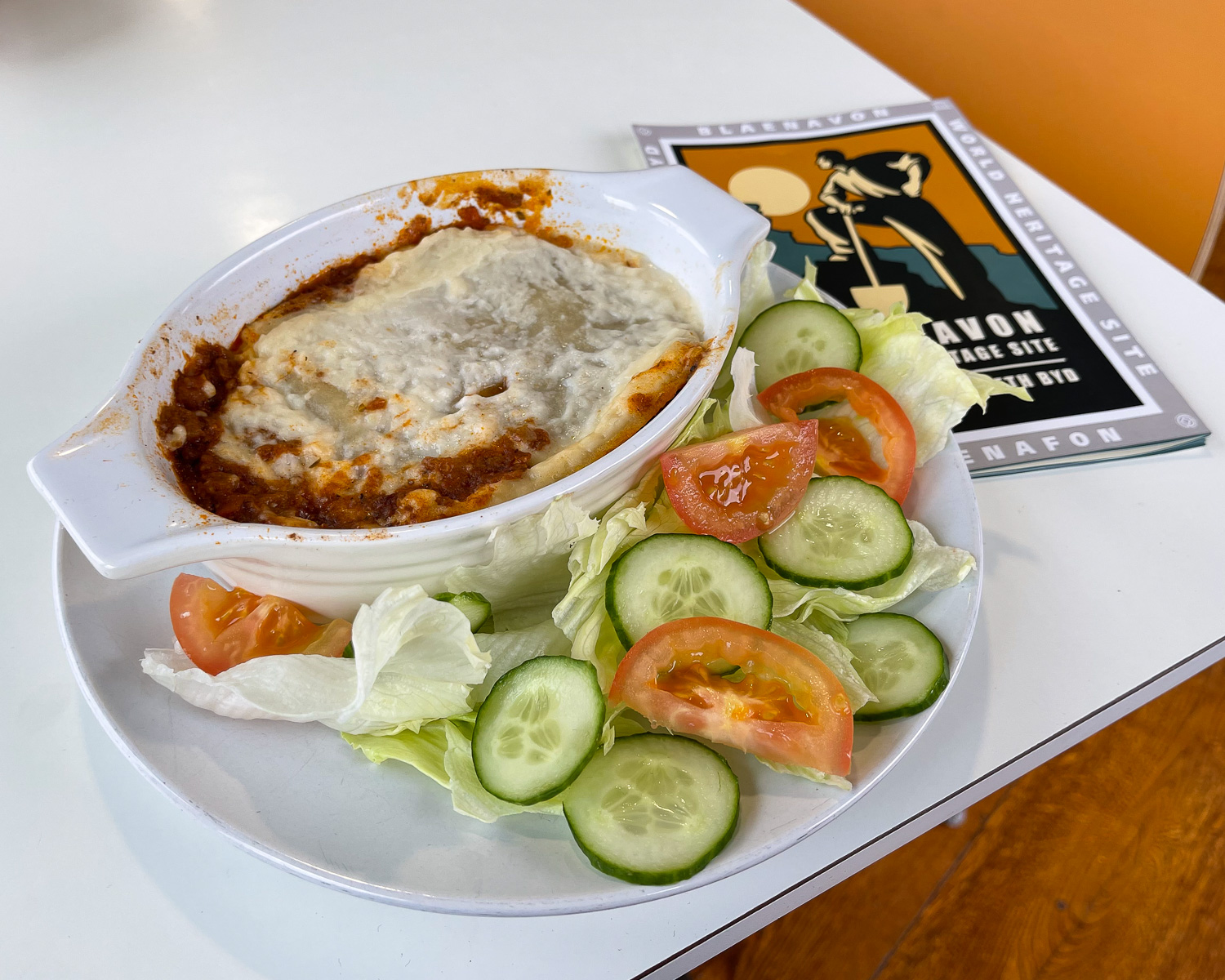
Other options include the Miner’s Canteen at Big Pit which serves a similar range of hot drinks, cakes and homely hot dishes, but you’d need to be visiting the Big Pit Museum to get in here (the museum is free but ticketed).
There are a few other pubs and cafes in and around Blaenavon town, but we didn’t visit them ourselves. If you are staying in the area and want a wide choice of excellent restaurants, Abergavenny is probably the best place to head for an evening meal – read my restaurant recommendations in this article about our visit to Abergavenny.

Need a guidebook for Wales? We recommend the Lonely Planet Wales Travel Guide
Walking around Blaenavon
One part of the Blaenavon World Heritage Landscape that surprised me was the beautiful walks and views of the surrounding hills and valleys, bearing in mind that this was once a heavily industrialised area. The northern part of the Blaenavon Heritage Landscape falls within the boundary of the Brecon Beacon National Park, and it was here that we had a chance to walk on Blorenge Mountain with our excellent guide Huw from Treads and Trails.
Walking on Blorenge Mountain
Our walk started at Keeper’s Pond, a man-made pond on the hillside above Blaenavon that was dug out in the early 19th century to provide a water feed for the forge nearby. There’s a handy car park beside the pond and we enjoyed watching the group of ladies braving the cold for a swim in the pond, with their fluorescent orange floats. Apparently in the summer, the pond is a magnet for swimmers, since there’s such a craze for wild swimming, although in November it’s only the most hardy regulars that swim here.
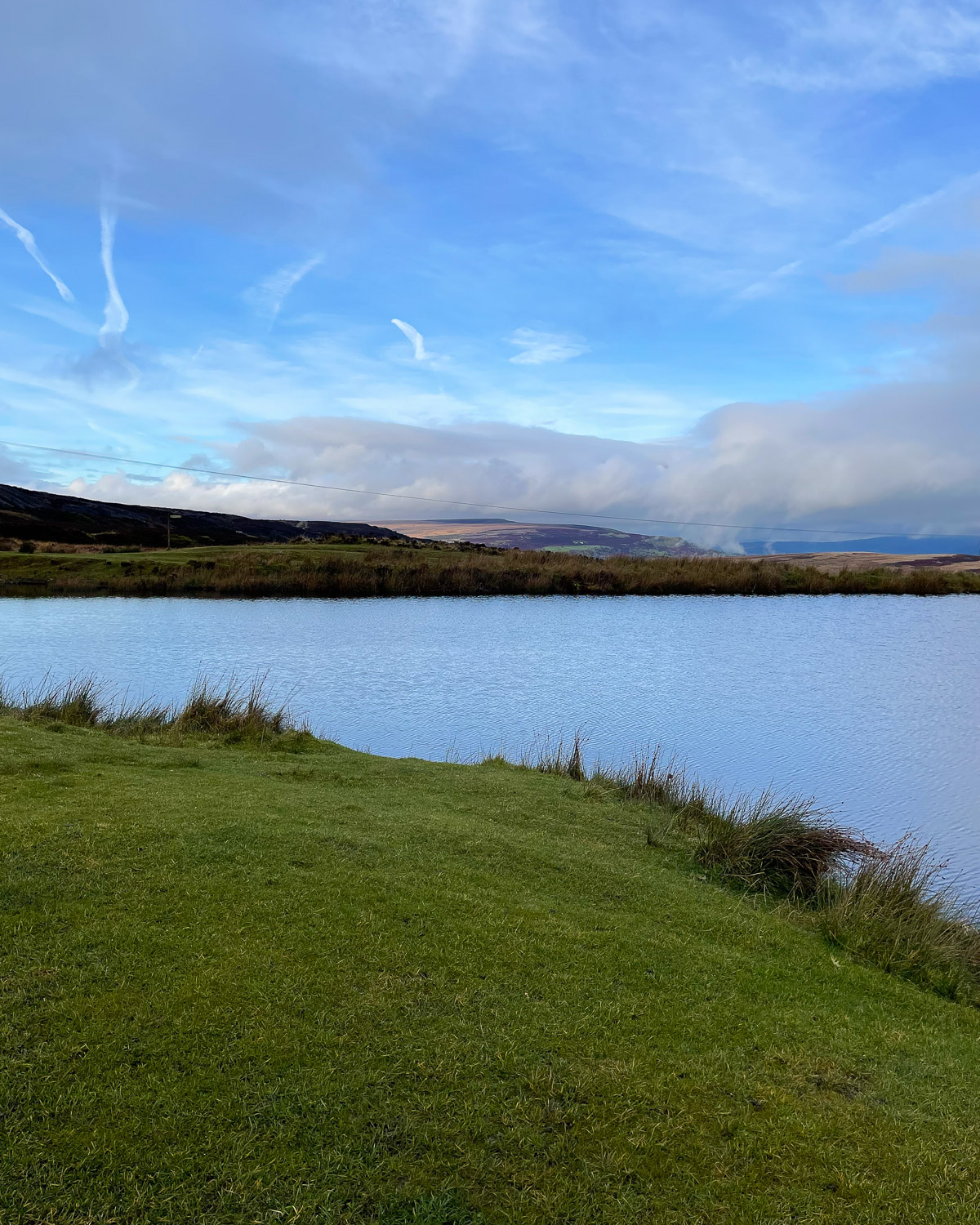
As our time was limited, we opted for the easy walk up to the crest of the Blorenge Mountain, following the gravel track up to the second Foxhunter car park, then climbing gently up on the heather covered hillside to the trig point at the top. Along the way, we passed the grave of the showjumping champion horse, Foxhunter, who won a gold medal in 1952 Olympics, together with his rider Sir Harry Llewellyn. If only we could all have a resting place with such a view!
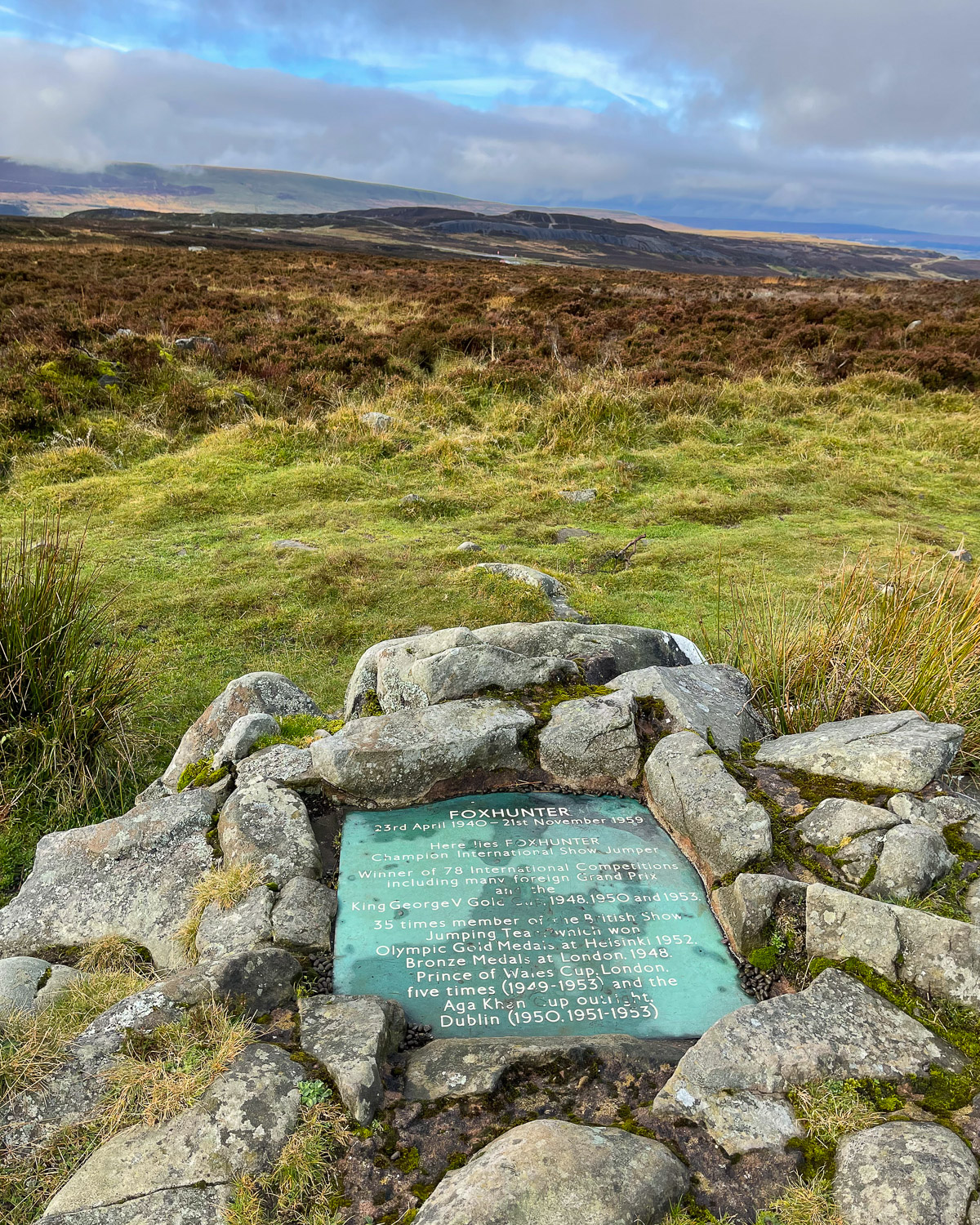
Read about the Wye Valley – what to see, where to eat and stay on your picturesque Wye tour
The views from Blorenge Mountain
After a gentle uphill walk we reached the trig point, at the summit at 560m of Blorenge Mountain. From here we had a panorama over the valleys below, with the neighbouring peaks of Sugarloaf and Skirrid in the distance and the town of Abergavenny just hidden by the contours of the hill.
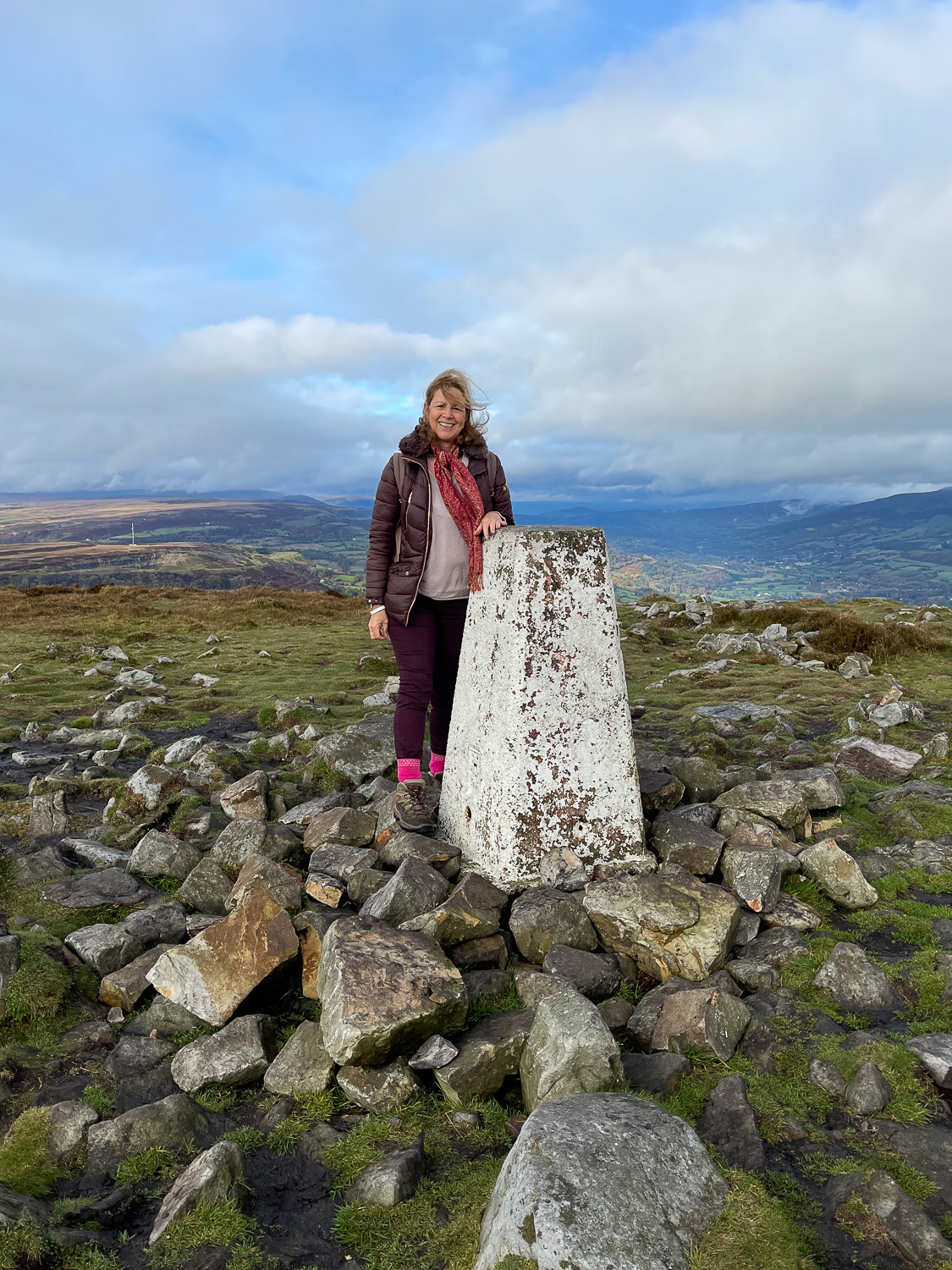
Had we more time, we could have followed the Iron Mountain trail, down the hill to the Punchbowl pond, with views over Abergavenny. It’s from this part of the mountain that hang-gliders take off to land on the meadows by the river below Abergavenny Castle. The 12 mile Iron Mountain Trail skirts around the side of the Blorenge mountain and passes an old tram road that took coal and iron ore down to the Monmouth and Brecon canal, where it could be shipped to the coast at Newport.
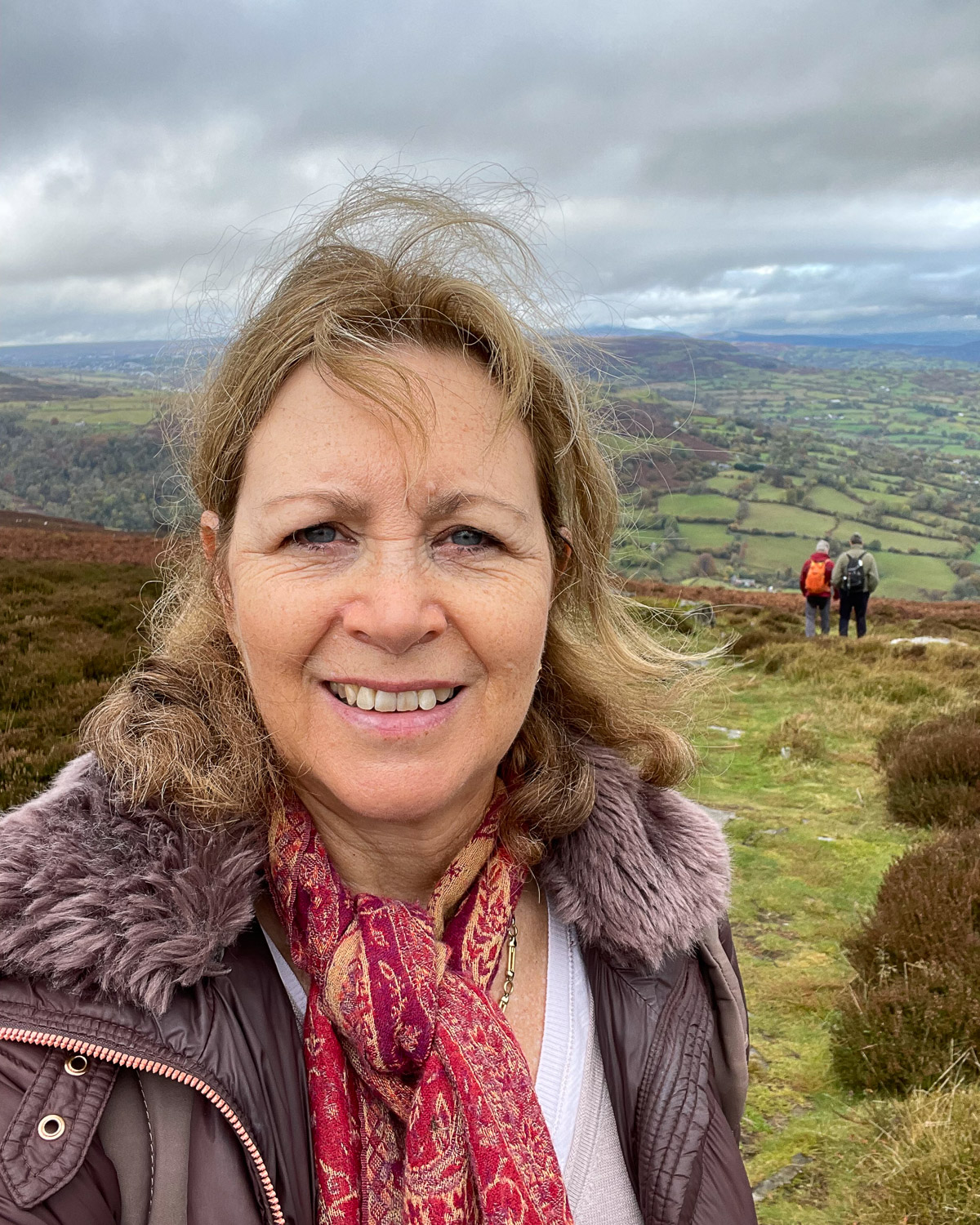
We made a short cut down the western side of the Blorenge, where we met the tram road and followed it back down the hill, returning to Keeper’s Pond. The clumps of Heather are home to Red Grouse and cover the hillside of Blorenge with a sheet of purple, when they are in full flower in late August and September.
More walks around Blaenavon
There are many more walks around Blaenavon to suit all fitness levels and you can download the walking leaflets from the Visit Blaenavon website or pick them up when you visit the Blaenavon World Heritage Centre.
There are a couple more that start at Keeper’s Pond:
Iron Mountain Trail – I’ve already mentioned this 12 mile circular walk that splits into two parts, each around 4 hours, starting from Keeper’s Pond. The walk around Blorenge mountain includes old tram roads and other features of the Blaenavon industrial landscape. (leaflets available to download)
Mynydd y Garn-Fawr walk – Starting at Keeper’s Pond, this 3 hour walk takes you up to the Foxhunter memorial and over the heather-clad mountain passing Bronze Age burial cairns. (leaflet available to download)
Other walks start from the Big Pit car park:
Whistle Stop Trail: This 3 hour walk runs alongside the heritage railway, past the picturesque Garn Lakes Nature Reserve and dramatic coal tips that have been reclaimed by nature. (leaflet available to download)
Coity Tip Trail: A short 15 mins walk around an old waste tip from the Coity Pit next to Big Pit, to learn about the wildlife, plants and natural habitats of the site. (leaflet available to download)
There are many more walks for all abilities, so take a look at the Visit Blaenavon website for more information or to download the leaflets.
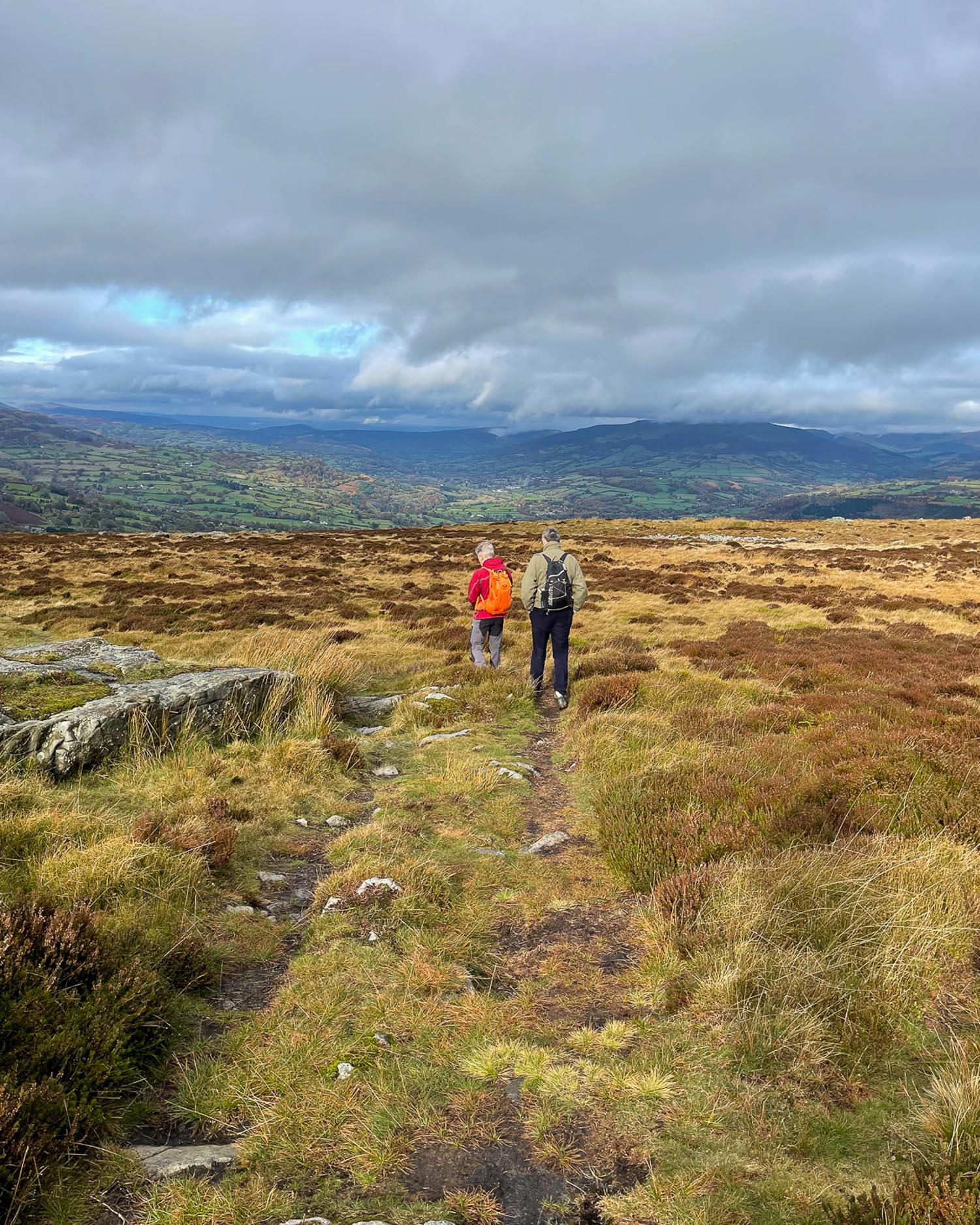
The Monmouthshire and Brecon Canal
The Monmouthshire and Brecon canal or “Mon and Brec” was constructed in the early 19th century, to provide a route to bring coal, iron ore and other industrial goods from the Welsh Valleys down to Newport. It runs for 32 miles through the Brecon Beacon National Park with a section within the Blaenavon World Heritage Site. Tramways were constructed along the hillsides, using gravity to transport the trucks of coal and ore to wharfs, where the barges would be filled and taken down the canal to Newport.
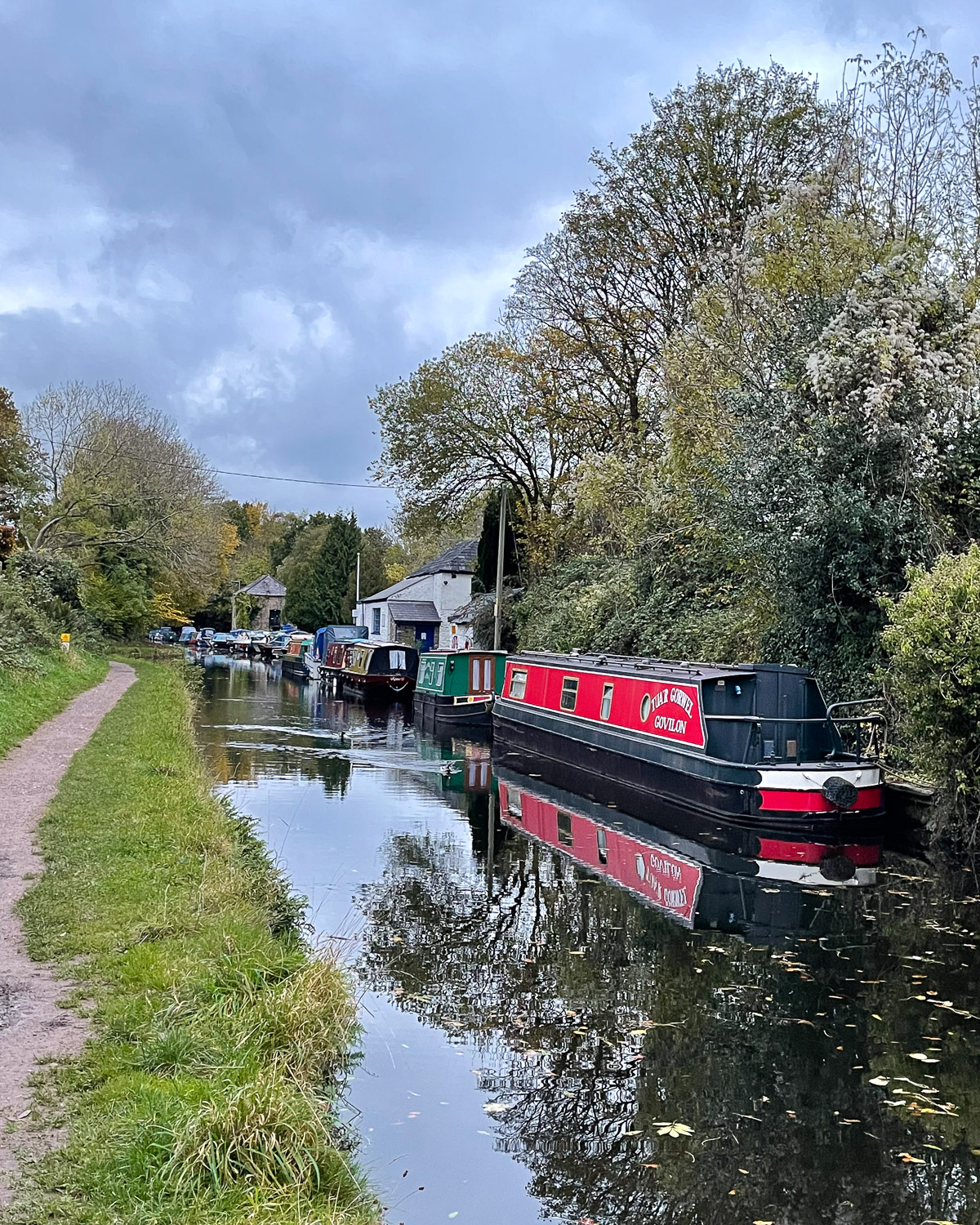
Walks along the Monmouthshire and Brecon Canal
We stopped at the end of the day for a quick look at the canal, which I’d visited before for some walking on the section that runs from Fourteen Locks Visitor Centre to Newport – read about it in my Guide to walking the Monmouthshire and Brecon Canal. This time we followed the road from Keeper’s Pond to Govilon Wharf, where there’s a small car park and you can see a number of canal barges tied up.
Other places to stop on the canal in this area include Goytre Wharf, where you can make the 8km walk along the towpath to Llanfoist Wharf just south of Aberganvenny (download the walking leaflet on the Visit Blaenavon website). There are parking spots close to all of the wharfs, so you can easily make your own walk along the towpath beside the canal.

Need a guidebook for Wales? We recommend the Lonely Planet Wales Travel Guide
Cottages near Blaenavon
While visiting Blaenavon and touring around other parts of South Wales, we stayed at Roundhouse Farm near Nantyglo. It’s about 15 minutes drive from Blaenavon and makes an excellent base if you want self catering accommodation that’s close to a range of attractions, such as the Blaenarvon World Heritage landscape, Welsh Valleys, Abergavenny and Brecon Beacons.
One quirk of the farm is that it includes one of the Round Towers, built by the local ironmasters, Joseph and Crawshay Bailey who owned the local ironworks. They constructed this and another nearby round tower in 1816, as a place of refuge, when their workers rioted as a result of their wages being cut. The towers were fitted out with cast iron from the foundry and the Grade II listed cottages where we stayed also had unusual cast iron roof supports.
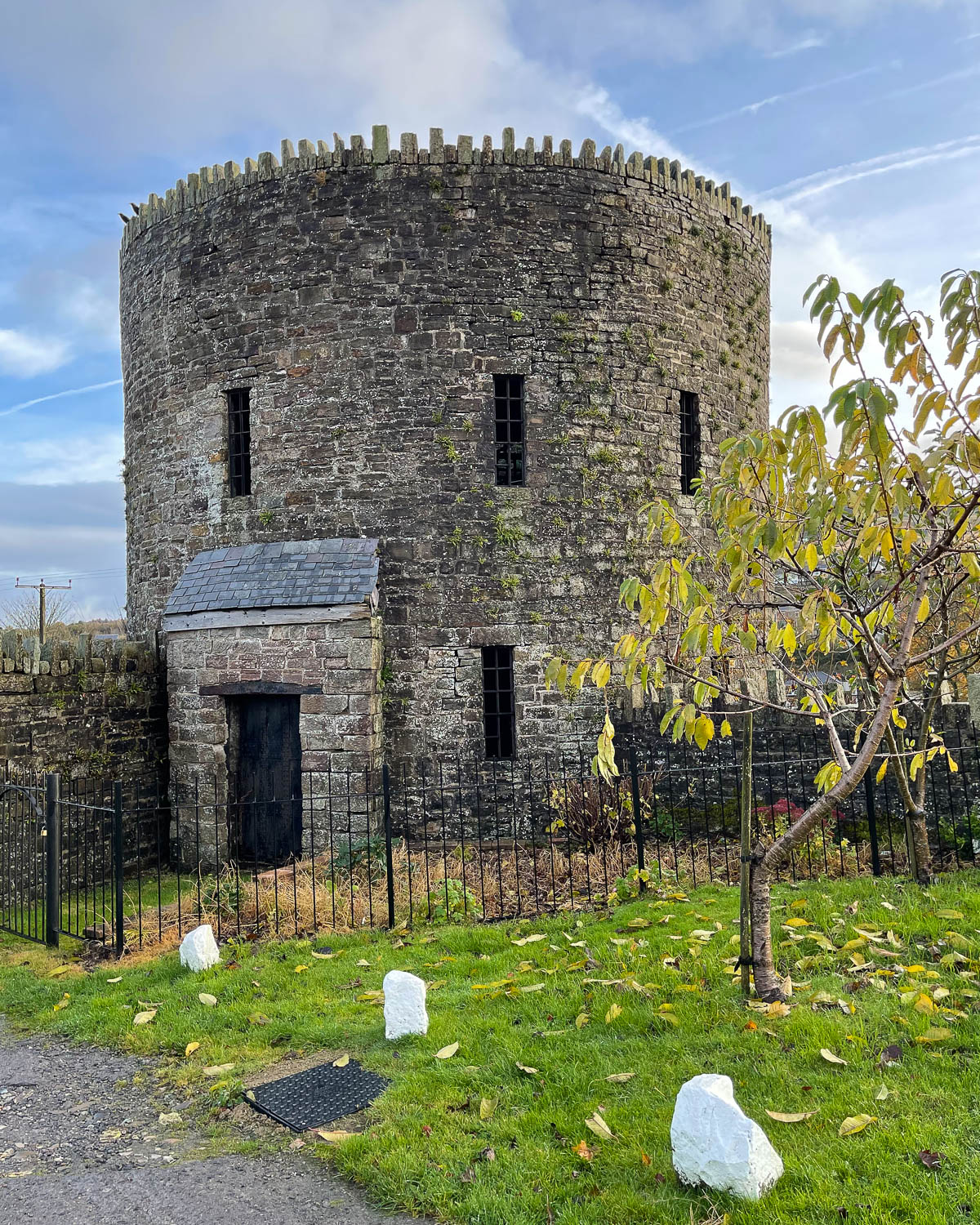
Round House Farm Cottages at Nantyglo
There are three cottages in a terrace at Round House Farm made from the original barn that forms one side of an enclosed farm yard. In the past working ponies from the mines and foundries would be kept securely in farmyards like this, since without them the works could not function.
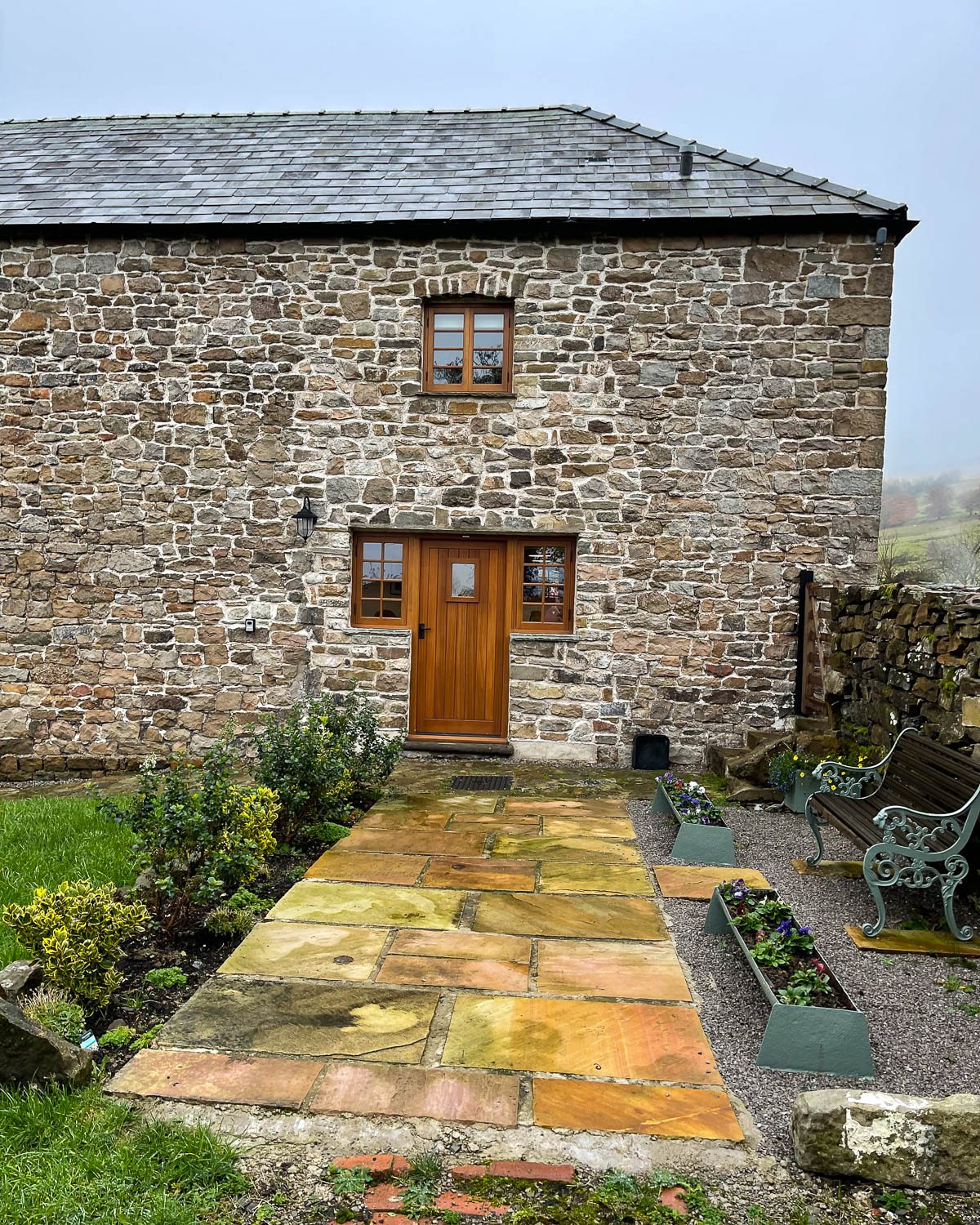
Ours was a two bedroom cottage, Henrietta, and it was a pleasure to stay in a Welsh cottage that was cosy and well equipped, but with fresh, contemporary furnishings. The open plan ground floor with stone flags and areas of decorative exposed stone walls, included plenty of seating, a dining table and a kitchen area.
Upstairs were a double and single bedroom that would be ideal for a family, styled with tasteful modern furniture and a large bathroom with shower. We found it very relaxing to look out on the green fields from our bedroom to see the sheep and horses grazing nearby.
Book here for Roundhouse Farm Henrietta Cottage or their other cottages, Mary and William.
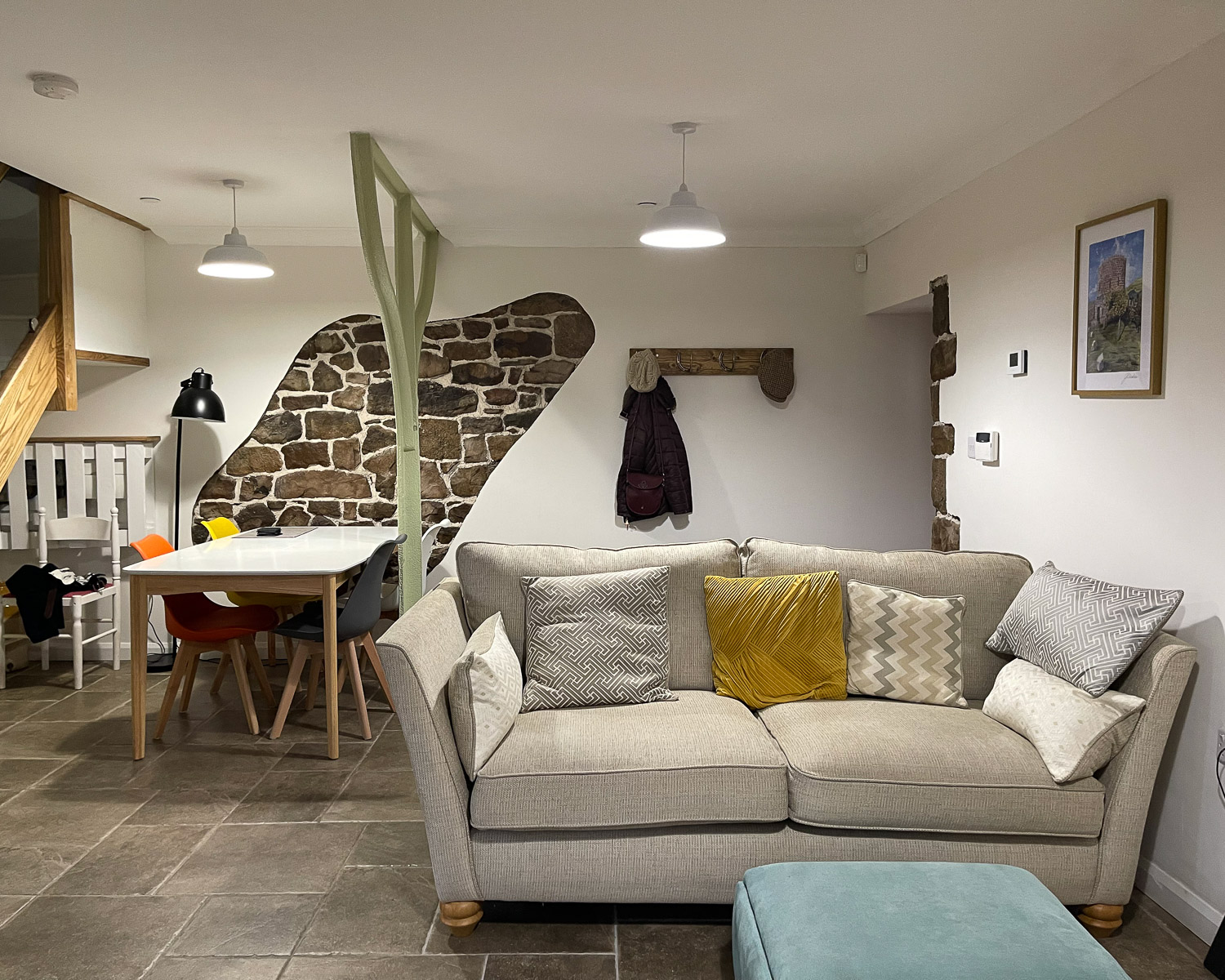
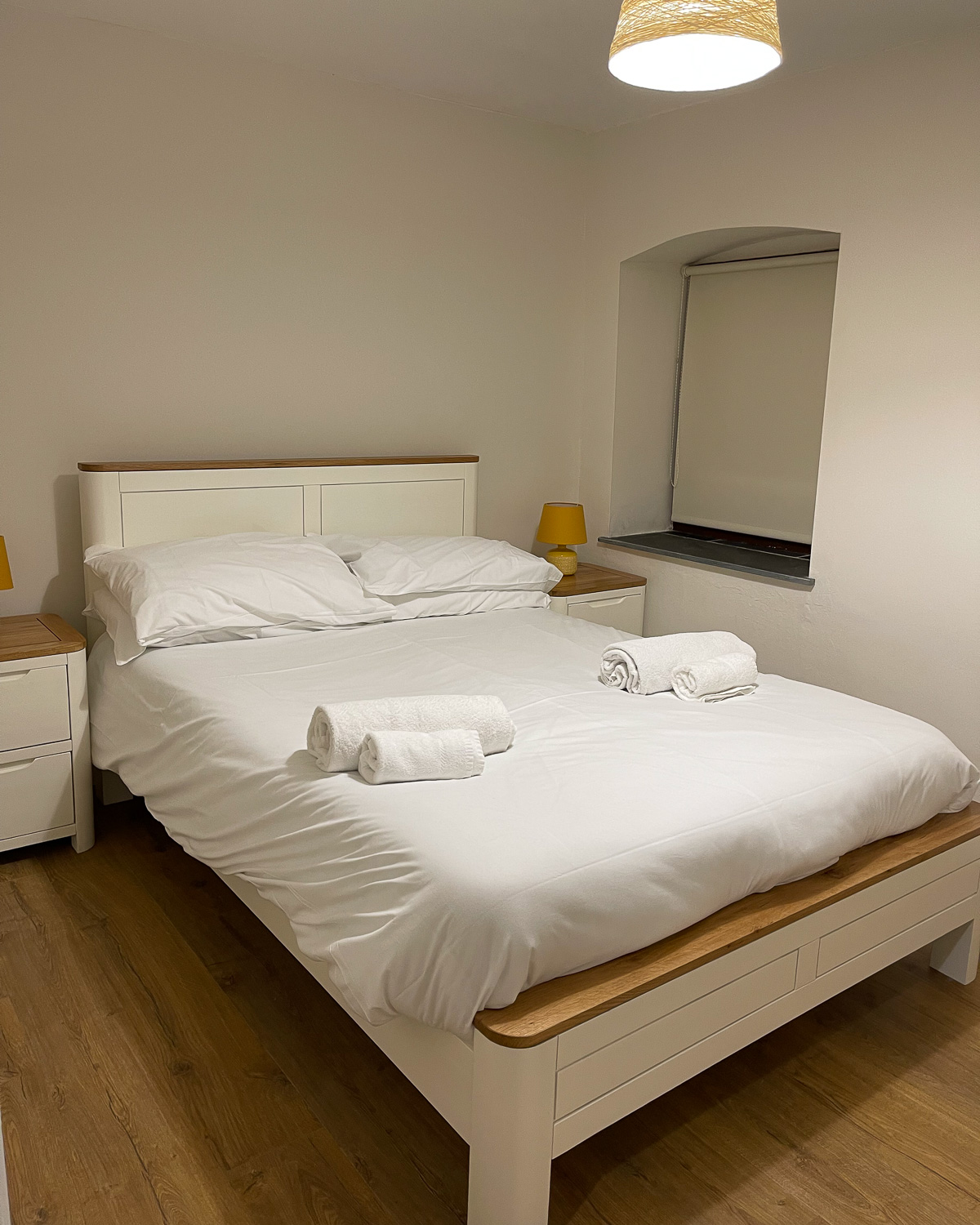
More hotels and guest houses near Blaenavon
The market town of Abergavenny is a 15 mins drive from Blaenavon and has a wide range of places to stay – check out:
The Angel Hotel – a former coaching inn with 35 bedrooms that’s been renovated to make a luxurious boutique hotel with two excellent restaurants in the heart of Abergavenny.
Kings Arms Hotel – a 16th century inn with 8 bedrooms that have been decorated in fresh, contemporary style.
Hardwick Farm – a bed and breakfast in a working dairy farm just outside Abergavenny, with elegant antique furnished rooms.
Check here for more hotels and guest houses in Abergavenny
Plan your visit to Blaenavon
You can find information on all the things to see within the Blaenavon Industrial Landscape on the Visit Blaenavon website and for other things to do in the surrounding area of Monmouthshire, take a look at the Visit Monmouthshire website. On social media follow the @SouthernWales, @VisitMonmouthshire and @Dargandecymru (Welsh language) instagram feeds for more inspiration.
Map of Blaenavon attractions
You’ll find an interactive map of the main Blaenavon attractions within the UNESCO World Heritage Landscape here.
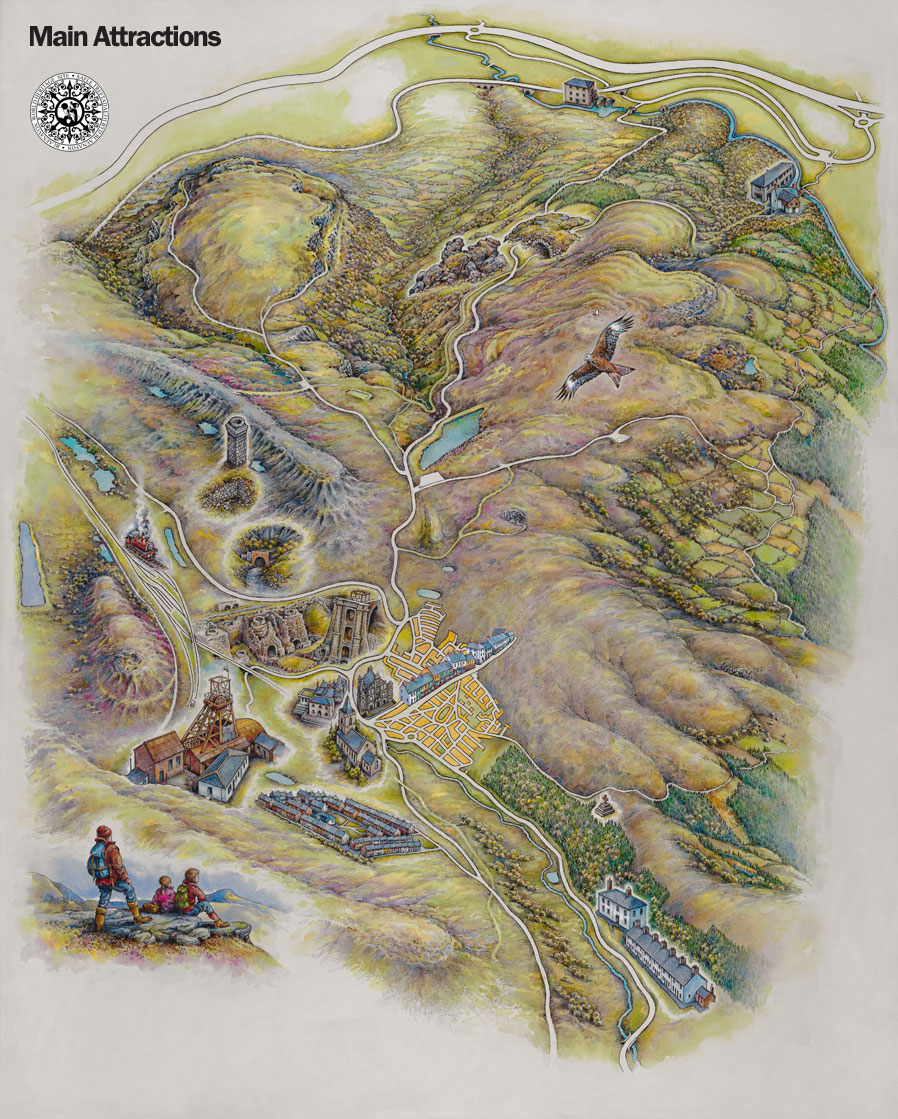
This article was sponsored* by Visit Monmouthshire and Southern Wales who provided some of the experiences and accommodation mentioned.
* More info on my policies page
Read Next
You may also enjoy exploring Tredegar Wales – in the footsteps of Aneurin Bevan, father of the NHS
You may also enjoy
10 cool things to do around Bristol Harbour
15 fun things to do in Stroud in the Cotswolds
Things to do in Bristol Old City – what to see and where to eat
Pin it
This article is originally published at Heatheronhertravels.com

